Rice
Rice is the seed of the grass species Oryza glaberrima (African rice) or Oryza sativa (Asian rice). As a cereal grain, it is the most widely consumed staple food for a large part of the world's human population, especially in Asia and Africa. It is the agricultural commodity with the third-highest worldwide production (rice, 741.5 million tonnes in 2014), after sugarcane (1.9 billion tonnes) and maize (1.0 billion tonnes).[1]
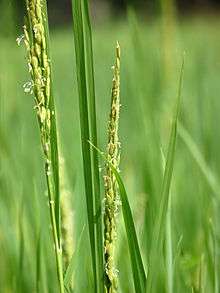

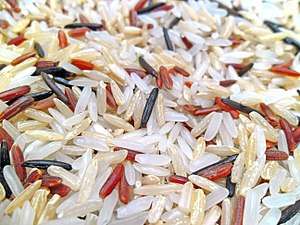
Since sizable portions of sugarcane and maize crops are used for purposes other than human consumption, rice is the most important grain with regard to human nutrition and caloric intake, providing more than one-fifth of the calories consumed worldwide by humans.[2] There are many varieties of rice and culinary preferences tend to vary regionally.
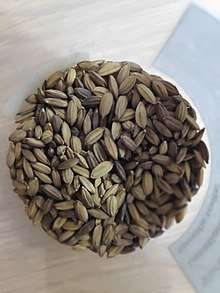
.jpg)
Rice, a monocot, is normally grown as an annual plant, although in tropical areas it can survive as a perennial and can produce a ratoon crop for up to 30 years.[3] Rice cultivation is well-suited to countries and regions with low labor costs and high rainfall, as it is labor-intensive to cultivate and requires ample water. However, rice can be grown practically anywhere, even on a steep hill or mountain area with the use of water-controlling terrace systems. Although its parent species are native to Asia and certain parts of Africa, centuries of trade and exportation have made it commonplace in many cultures worldwide.
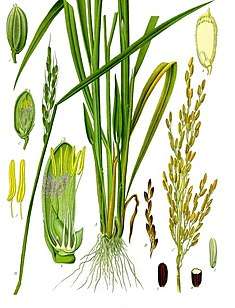
The traditional method for cultivating rice is flooding the fields while, or after, setting the young seedlings. This simple method requires sound planning and servicing of the water damming and channeling, but reduces the growth of less robust weed and pest plants that have no submerged growth state, and deters vermin. While flooding is not mandatory for the cultivation of rice, all other methods of irrigation require higher effort in weed and pest control during growth periods and a different approach for fertilizing the soil.
The name wild rice is usually used for species of the genera Zizania and Porteresia, both wild and domesticated, although the term may also be used for primitive or uncultivated varieties of Oryza.
Etymology
First used in English in the middle of the 13th century, the word "rice" derives from the Old French ris, which comes from the Italian riso, in turn from the Latin orȳza, which derives from the Greek ὄρυζα (oruza). The Greek word is the source of all European words (compare Welsh reis, German Reis, Lithuanian ryžiai, Serbo-Croatian riža, Polish ryż, Dutch rijst, Hungarian rizs, Romanian orez, Spanish arroz).[4][5][6]
The origin of the Greek word is unclear. It is sometimes held to be from the Tamil word அரிசி (arisi), or rather Old Tamil 𑀅𑀭𑀺𑀘𑀺 (arici).[7][8] However, Krishnamurti[9] disagrees with the notion that Old Tamil arici is the source of the Greek term, and proposes that it was borrowed from descendants of Proto-Dravidian *wariñci instead. Mayrhofer[10] suggests that the immediate source of the Greek word is to be sought in Old Iranian words of the types *vrīz- or *vrinj-, source of the modern Persian word برنج (berenj), but these are ultimately traced back to Indo-Aryan (as in Sanskrit व्रीहि, vrīhí-).
Characteristics
The rice plant can grow to 1–1.8 m (3.3–5.9 ft) tall, occasionally more depending on the variety and soil fertility. It has long, slender leaves 50–100 cm (20–39 in) long and 2–2.5 cm (0.79–0.98 in) broad. The small wind-pollinated flowers are produced in a branched arching to pendulous inflorescence 30–50 cm (12–20 in) long. The edible seed is a grain (caryopsis) 5–12 mm (0.20–0.47 in) long and 2–3 mm (0.079–0.118 in) thick.
Origin
Origin of rice domestication has been a subject of much debate among those who study crop history and anthropology - whether rice originated in India or China.[11][12] Asian rice, Oryza sativa, is one of oldest crop species. It has tens of thousands of varieties and two major subspecies, japonica and indica. Archeologists focusing on East and Southeast Asia argue that rice farming began in south-central China along the Yangzte River and spread to Korea and Japan from there south and northeast.[13][12] Archaeologists working in India argue that rice cultivation started in the valley of the Ganges River[14] and Indus valley,[15] by peoples unconnected to those of the Yangzte.[16][17][12]
Cooking
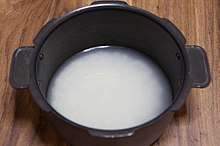
The varieties of rice are typically classified as long-, medium-, and short-grained.[18] The grains of long-grain rice (high in amylose) tend to remain intact after cooking; medium-grain rice (high in amylopectin) becomes more sticky. Medium-grain rice is used for sweet dishes, for risotto in Italy, and many rice dishes, such as arròs negre, in Spain. Some varieties of long-grain rice that are high in amylopectin, known as Thai Sticky rice, are usually steamed.[19] A stickier medium-grain rice is used for sushi; the stickiness allows rice to hold its shape when molded. Medium-grain rice is used extensively in Japan, including to accompany savoury dishes, where it is usually served plain in a separate dish. Short-grain rice is often used for rice pudding.
Instant rice differs from parboiled rice in that it is fully cooked and then dried, though there is a significant degradation in taste and texture. Rice flour and starch often are used in batters and breadings to increase crispiness.
Preparation
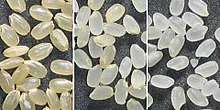
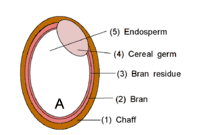
B: Brown rice
C: Rice with germ
D: White rice with bran residue
E: Musenmai (Japanese: 無洗米), "Polished and ready to boil rice", literally, non-wash rice
(1): Chaff
(2): Bran
(3): Bran residue
(4): Cereal germ
(5): Endosperm
Rice is typically rinsed before cooking to remove excess starch. Rice produced in the US is usually fortified with vitamins and minerals, and rinsing will result in a loss of nutrients. Rice may be rinsed repeatedly until the rinse water is clear to improve the texture and taste.
Rice may be soaked to decrease cooking time, conserve fuel, minimize exposure to high temperature, and reduce stickiness. For some varieties, soaking improves the texture of the cooked rice by increasing expansion of the grains. Rice may be soaked for 30 minutes up to several hours.
Brown rice may be soaked in warm water for 20 hours to stimulate germination. This process, called germinated brown rice (GBR),[20] activates enzymes and enhances amino acids including gamma-aminobutyric acid to improve the nutritional value of brown rice. This method is a result of research carried out for the United Nations International Year of Rice.
Rice is cooked by boiling or steaming, and absorbs water during cooking. With the absorption method, rice may be cooked in a volume of water equal to the volume of dry rice plus any evaporation losses.[21] With the rapid-boil method, rice may be cooked in a large quantity of water which is drained before serving. Rapid-boil preparation is not desirable with enriched rice, as much of the enrichment additives are lost when the water is discarded. Electric rice cookers, popular in Asia and Latin America, simplify the process of cooking rice. Rice (or any other grain) is sometimes quickly fried in oil or fat before boiling (for example saffron rice or risotto); this makes the cooked rice less sticky, and is a cooking style commonly called pilaf in Iran and Afghanistan or biryani in India and Pakistan .
Dishes
In Arab cuisine, rice is an ingredient of many soups and dishes with fish, poultry, and other types of meat. It is used to stuff vegetables or is wrapped in grape leaves (dolma). When combined with milk, sugar, and honey, it is used to make desserts. In some regions, such as Tabaristan, bread is made using rice flour. Rice may be made into congee (also called rice porridge or rice gruel) by adding more water than usual, so that the cooked rice is saturated with water, usually to the point that it disintegrates. Rice porridge is commonly eaten as a breakfast food, and is a traditional food for the sick.
Food
Nutrition
Rice is the staple food of over half the world's population. It is the predominant dietary energy source for 17 countries in Asia and the Pacific, 9 countries in North and South America and 8 countries in Africa. Rice provides 20% of the world's dietary energy supply, while wheat supplies 19% and maize (corn) 5%.[22]
Cooked, unenriched, white, long-grained rice is composed of 68% water, 28% carbohydrates, 3% protein, and negligible fat (table). In a 100 gram serving, it provides 130 calories and contains no micronutrients in significant amounts, with all less than 10% of the Daily Value (DV) (table). Cooked, white, short-grained rice also provides 130 calories and contains moderate amounts of B vitamins, iron, and manganese (10–17% DV) per 100 gram amount (table).
A detailed analysis of nutrient content of rice suggests that the nutrition value of rice varies based on a number of factors. It depends on the strain of rice, such as white, brown, red, and black (or purple) varieties having different prevalence across world regions.[23] It also depends on nutrient quality of the soil rice is grown in, whether and how the rice is polished or processed, the manner it is enriched, and how it is prepared before consumption.[24]
A 2018 World Health Organization (WHO) guideline showed that fortification of rice to reduce malnutrition may involve different micronutrient strategies, including iron only, iron with zinc, vitamin A, and folic acid, or iron with other B-complex vitamins, such as thiamin, niacin, vitamin B6, and pantothenic acid.[23] A systematic review of clinical research on the efficacy of rice fortification showed the strategy had the main effect of reducing the risk of iron deficiency by 35% and increasing blood levels of hemoglobin.[23] The guideline established a major recommendation: "Fortification of rice with iron is recommended as a public health strategy to improve the iron status of populations, in settings where rice is a staple food."[23]
Rice grown experimentally under elevated carbon dioxide levels, similar to those predicted for the year 2100 as a result of human activity, had less iron, zinc, and protein, as well as lower levels of thiamin, riboflavin, folic acid, and pantothenic acid.[25]
| Nutrient | Maize (corn)[A] | Rice, white[B] | Wheat[C] | Potatoes[D] | Cassava[E] | Soybeans, green[F] | Sweet potatoes[G] | Yams[Y] | Sorghum[H] | Plantain[Z] | RDA |
|---|---|---|---|---|---|---|---|---|---|---|---|
| Water (g) | 10 | 12 | 13 | 79 | 60 | 68 | 77 | 70 | 9 | 65 | 3,000 |
| Energy (kJ) | 1,528 | 1,528 | 1,369 | 322 | 670 | 615 | 360 | 494 | 1,419 | 511 | 8,368–10,460 |
| Protein (g) | 9.4 | 7.1 | 12.6 | 2.0 | 1.4 | 13.0 | 1.6 | 1.5 | 11.3 | 1.3 | 50 |
| Fat (g) | 4.74 | 0.66 | 1.54 | 0.09 | 0.28 | 6.8 | 0.05 | 0.17 | 3.3 | 0.37 | 44–77 |
| Carbohydrates (g) | 74 | 80 | 71 | 17 | 38 | 11 | 20 | 28 | 75 | 32 | 130 |
| Fiber (g) | 7.3 | 1.3 | 12.2 | 2.2 | 1.8 | 4.2 | 3 | 4.1 | 6.3 | 2.3 | 30 |
| Sugar (g) | 0.64 | 0.12 | 0.41 | 0.78 | 1.7 | 0 | 4.18 | 0.5 | 0 | 15 | minimal |
| Minerals | [A] | [B] | [C] | [D] | [E] | [F] | [G] | [Y] | [H] | [Z] | RDA |
| Calcium (mg) | 7 | 28 | 29 | 12 | 16 | 197 | 30 | 17 | 28 | 3 | 1,000 |
| Iron (mg) | 2.71 | 0.8 | 3.19 | 0.78 | 0.27 | 3.55 | 0.61 | 0.54 | 4.4 | 0.6 | 8 |
| Magnesium (mg) | 127 | 25 | 126 | 23 | 21 | 65 | 25 | 21 | 0 | 37 | 400 |
| Phosphorus (mg) | 210 | 115 | 288 | 57 | 27 | 194 | 47 | 55 | 287 | 34 | 700 |
| Potassium (mg) | 287 | 115 | 363 | 421 | 271 | 620 | 337 | 816 | 350 | 499 | 4,700 |
| Sodium (mg) | 35 | 5 | 2 | 6 | 14 | 15 | 55 | 9 | 6 | 4 | 1,500 |
| Zinc (mg) | 2.21 | 1.09 | 2.65 | 0.29 | 0.34 | 0.99 | 0.3 | 0.24 | 0 | 0.14 | 11 |
| Copper (mg) | 0.31 | 0.22 | 0.43 | 0.11 | 0.10 | 0.13 | 0.15 | 0.18 | - | 0.08 | 0.9 |
| Manganese (mg) | 0.49 | 1.09 | 3.99 | 0.15 | 0.38 | 0.55 | 0.26 | 0.40 | - | - | 2.3 |
| Selenium (μg) | 15.5 | 15.1 | 70.7 | 0.3 | 0.7 | 1.5 | 0.6 | 0.7 | 0 | 1.5 | 55 |
| Vitamins | [A] | [B] | [C] | [D] | [E] | [F] | [G] | [Y] | [H] | [Z] | RDA |
| Vitamin C (mg) | 0 | 0 | 0 | 19.7 | 20.6 | 29 | 2.4 | 17.1 | 0 | 18.4 | 90 |
| Thiamin (B1) (mg) | 0.39 | 0.07 | 0.30 | 0.08 | 0.09 | 0.44 | 0.08 | 0.11 | 0.24 | 0.05 | 1.2 |
| Riboflavin (B2) (mg) | 0.20 | 0.05 | 0.12 | 0.03 | 0.05 | 0.18 | 0.06 | 0.03 | 0.14 | 0.05 | 1.3 |
| Niacin (B3) (mg) | 3.63 | 1.6 | 5.46 | 1.05 | 0.85 | 1.65 | 0.56 | 0.55 | 2.93 | 0.69 | 16 |
| Pantothenic acid (B5) (mg) | 0.42 | 1.01 | 0.95 | 0.30 | 0.11 | 0.15 | 0.80 | 0.31 | - | 0.26 | 5 |
| Vitamin B6 (mg) | 0.62 | 0.16 | 0.3 | 0.30 | 0.09 | 0.07 | 0.21 | 0.29 | - | 0.30 | 1.3 |
| Folate Total (B9) (μg) | 19 | 8 | 38 | 16 | 27 | 165 | 11 | 23 | 0 | 22 | 400 |
| Vitamin A (IU) | 214 | 0 | 9 | 2 | 13 | 180 | 14,187 | 138 | 0 | 1,127 | 5,000 |
| Vitamin E, alpha-tocopherol (mg) | 0.49 | 0.11 | 1.01 | 0.01 | 0.19 | 0 | 0.26 | 0.39 | 0 | 0.14 | 15 |
| Vitamin K1 (μg) | 0.3 | 0.1 | 1.9 | 1.9 | 1.9 | 0 | 1.8 | 2.6 | 0 | 0.7 | 120 |
| Beta-carotene (μg) | 97 | 0 | 5 | 1 | 8 | 0 | 8,509 | 83 | 0 | 457 | 10,500 |
| Lutein+zeaxanthin (μg) | 1,355 | 0 | 220 | 8 | 0 | 0 | 0 | 0 | 0 | 30 | 6,000 |
| Fats | [A] | [B] | [C] | [D] | [E] | [F] | [G] | [Y] | [H] | [Z] | RDA |
| Saturated fatty acids (g) | 0.67 | 0.18 | 0.26 | 0.03 | 0.07 | 0.79 | 0.02 | 0.04 | 0.46 | 0.14 | minimal |
| Monounsaturated fatty acids (g) | 1.25 | 0.21 | 0.2 | 0.00 | 0.08 | 1.28 | 0.00 | 0.01 | 0.99 | 0.03 | 22–55 |
| Polyunsaturated fatty acids (g) | 2.16 | 0.18 | 0.63 | 0.04 | 0.05 | 3.20 | 0.01 | 0.08 | 1.37 | 0.07 | 13–19 |
| [A] | [B] | [C] | [D] | [E] | [F] | [G] | [Y] | [H] | [Z] | RDA |
A raw yellow dent corn
B raw unenriched long-grain white rice
C raw hard red winter wheat
D raw potato with flesh and skin
E raw cassava
F raw green soybeans
G raw sweet potato
H raw sorghum
Y raw yam
Z raw plantains
/* unofficial
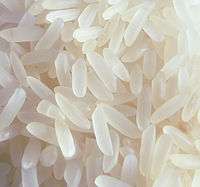 | |
| Nutritional value per 100 g (3.5 oz) | |
|---|---|
| Energy | 130 kcal (540 kJ) |
28.1 g | |
| Sugars | 0.05 g |
| Dietary fiber | 0.4 g |
0.28 g | |
2.69 g | |
| Vitamins | Quantity %DV† |
| Thiamine (B1) | 2% 0.02 mg |
| Riboflavin (B2) | 1% 0.013 mg |
| Niacin (B3) | 3% 0.4 mg |
| Pantothenic acid (B5) | 0% 0 mg |
| Vitamin B6 | 7% 0.093 mg |
| Minerals | Quantity %DV† |
| Calcium | 1% 10 mg |
| Iron | 2% 0.2 mg |
| Magnesium | 3% 12 mg |
| Manganese | 0% 0 mg |
| Phosphorus | 6% 43 mg |
| Potassium | 1% 35 mg |
| Sodium | 0% 1 mg |
| Zinc | 1% 0.049 mg |
| Other constituents | Quantity |
| Water | 68.44 g |
| |
| †Percentages are roughly approximated using US recommendations for adults. Source: USDA Nutrient Database | |
| Nutritional value per 100 g (3.5 oz) | |
|---|---|
| Energy | 544 kJ (130 kcal) |
28.73 g | |
| Sugars | 0 g |
| Dietary fiber | 0 g |
0.19 g | |
2.36 g | |
| Vitamins | Quantity %DV† |
| Thiamine (B1) | 2% 0.02 mg |
| Riboflavin (B2) | 1% 0.016 mg |
| Niacin (B3) | 3% 0.4 mg |
| Pantothenic acid (B5) | 8% 0.4 mg |
| Vitamin B6 | 13% 0.164 mg |
| Minerals | Quantity %DV† |
| Calcium | 0% 1 mg |
| Iron | 2% 0.20 mg |
| Magnesium | 2% 8 mg |
| Manganese | 19% 0.4 mg |
| Phosphorus | 5% 33 mg |
| Potassium | 1% 26 mg |
| Zinc | 4% 0.4 mg |
| Other constituents | Quantity |
| Water | 68.53 g |
| |
| †Percentages are roughly approximated using US recommendations for adults. Source: USDA Nutrient Database | |
Arsenic concerns
As arsenic is a natural element in soil, water, and air, the United States Food and Drug Administration (FDA) monitors the levels of arsenic in foods, particularly in rice products used commonly for infant food.[27] While growing, rice plants tend to absorb arsenic more readily than other food crops, requiring expanded testing by the FDA for possible arsenic-related risks associated with rice consumption in the United States.[27] In April 2016, the FDA proposed a limit of 100 parts per billion (ppb) for inorganic arsenic in infant rice cereal and other foods to minimize exposure of infants to arsenic.[27] For water contamination by arsenic, the United States Environmental Protection Agency has set a lower standard of 10 ppb.[28]
Arsenic is a Group 1 carcinogen.[27][29] The amount of arsenic in rice varies widely with the greatest concentration in brown rice and rice grown on land formerly used to grow cotton, such as in Arkansas, Louisiana, Missouri, and Texas.[30] White rice grown in Arkansas, Louisiana, Missouri, and Texas, which account collectively for 76 percent of American-produced rice, had higher levels of arsenic than other regions of the world studied, possibly because of past use of arsenic-based pesticides to control cotton weevils.[31] Jasmine rice from Thailand and Basmati rice from Pakistan and India contain the least arsenic among rice varieties in one study.[32] China has set a limit of 150 ppb for arsenic in rice.[33]
Bacillus cereus
Cooked rice can contain Bacillus cereus spores, which produce an emetic toxin when left at 4–60 °C (39–140 °F). When storing cooked rice for use the next day, rapid cooling is advised to reduce the risk of toxin production.[34] One of the enterotoxins produced by Bacillus cereus is heat-resistant; reheating contaminated rice kills the bacteria, but does not destroy the toxin already present.
Other uses
Medieval Islamic texts spoke of medical uses for the plant.[35]
Rice-growing environments
Rice can be grown in different environments, depending upon water availability.[36] Generally, rice does not thrive in a waterlogged area, yet it can survive and grow herein[37] and it can survive flooding.[38]
- Lowland, rainfed, which is drought prone, favors medium depth; waterlogged, submergence, and flood prone
- Lowland, irrigated, grown in both the wet season and the dry season
- Deep water or floating rice
- Coastal wetland
- Upland rice is also known as Ghaiya rice, well known for its drought tolerance[39]
History of domestication and cultivation
Origins in China
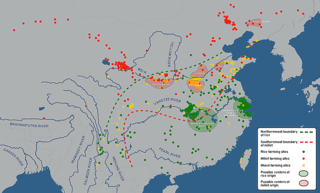
The current scientific consensus, based on archaeological and linguistic evidence, is that rice was first domesticated in the Yangtze River basin in China.[41][42][43][44] Because the functional allele for nonshattering, the critical indicator of domestication in grains, as well as five other single-nucleotide polymorphisms, is identical in both indica and japonica, Vaughan et al. (2008) determined a single domestication event for O. sativa.[42] This was supported by a genetic study in 2011 that showed that all forms of Asian rice, both indica and japonica, sprang from a single domestication event that occurred 13,500 to 8,200 years ago in China from the wild rice Oryza rufipogon.[45] A more recent population genomic study indicates that japonica was domesticated first, and that indica rice arose when japonica arrived in India about ~4,500 years ago and hybridized with an undomesticated proto-indica or wild O. nivara.[46]
There are two most likely centers of domestication for rice as well as the development of the wetland agriculture technology. The first, and most likely, is in the lower Yangtze River, believed to be the homelands of the pre-Austronesians and possibly also the Kra-Dai, and associated with the Kauhuqiao, Hemudu, Majiabang, Songze, Liangzhu, and Maqiao cultures. It is characterized by pre-Austronesian features, including stilt houses, jade carving, and boat technologies. Their diet were also supplemented by acorns, water chestnuts, foxnuts, and pig domestication.[44][40][47][48][49]
The second is in the middle Yangtze River, believed to be the homelands of the early Hmong-Mien-speakers and associated with the Pengtoushan, Nanmuyuan, Liulinxi, Daxi, Qujialing, and Shijiahe cultures. Both of these regions were heavily populated and had regular trade contacts with each other, as well as with early Austroasiatic speakers to the west, and early Kra-Dai speakers to the south, facilitating the spread of rice cultivation throughout southern China.[40][47][49]
Rice was gradually introduced north into early Sino-Tibetan Yangshao and Dawenkou culture millet farmers, either via contact with the Daxi culture or the Majiabang-Hemudu culture. By around 4000 to 3800 BC, they were a regular secondary crop among southernmost Sino-Tibetan cultures. It did not replace millet, largely because of different environment conditions in northern China, but it was cultivated alongside millet in the southern boundaries of the millet-farming regions. Conversely, millet was also introduced into rice-farming regions.[40][50]
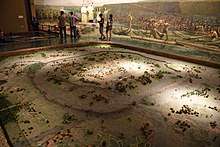
By the late Neolithic (3500 to 2500 BC), population in the rice cultivating centers had increased rapidly, centered around the Qujialing-Shijiahe culture and the Liangzhu culture. There was also evidence of intensive rice cultivation in paddy fields as well as increasingly sophisticated material cultures in these two regions. The number of settlements among the Yangtze cultures and their sizes increased, leading some archeologists to characterize them as true states, with clearly advanced socio-political structures. However, it is unknown if they had centralized control.[51][52]
Liangzhu and Shijiahe declined abruptly in the terminal Neolithic (2500 to 2000 BC). With Shijiahe shrinking in size, and Liangzhu disappearing altogether. This is largely believed to be the result of the southward expansion of the early Sino-Tibetan Longshan culture. Fortifications like walls (as well as extensive moats in Liangzhu cities) are common features in settlements during this period, indicating widespread conflict. This period also coincides with the southward movement of rice-farming cultures to the Lingnan and Fujian regions, as well as the southward migrations of the Austronesian, Kra-Dai, and Austroasiatic-speaking peoples to Mainland Southeast Asia and Island Southeast Asia.[51][53][54] A genomic study also indicates that at around this time, a global cooling event (the 4.2 k event) led to tropical japonica rice being pushed southwards, as well as the evolution of temperate japonica rice that could grow in more northern latitudes.[55]
Genomic studies suggests that indica rice arrives in China from India between 2,000 and 1,400 years ago.[55]
Southeast Asia
The spread of japonica rice cultivation to Southeast Asia started with the migrations of the Austronesian Dapenkeng culture into Taiwan between 3500 and 2000 BC (5,500 BP to 4,000 BP). The Nanguanli site in Taiwan, dated to ca. 2800 BC, has yielded numerous carbonized remains of both rice and millet in waterlogged conditions, indicating intensive wetland rice cultivation and dryland millet cultivation.[47] A multidisciplinary study using rice genome sequences indicate that tropical japonica rice was pushed southwards from China after a global cooling event (the 4.2k event) that occurred approximately 4,200 years ago.[55]
.png)
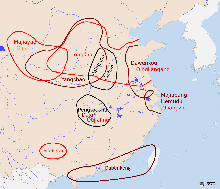
(8500 to 1500 BC)
From about 2000 to 1500 BC, the Austronesian expansion began, with settlers from Taiwan moving south to colonize Luzon in the Philippines, bringing rice cultivation technologies with them. From Luzon, Austronesians rapidly colonized the rest of Island Southeast Asia, moving westwards to Borneo, the Malay Peninsula and Sumatra; and southwards to Sulawesi and Java. By 500 BC, there is evidence of intensive wetland rice agriculture already established in Java and Bali, especially near very fertile volcanic islands.[47]
.png)
(3500 BC to AD 1200)
However, rice (as well as dogs and pigs) did not survive the first Austronesian voyages into Micronesia due to the sheer distance of ocean they were crossing. These voyagers became the ancestors of the Lapita culture. By the time they migrated southwards to the Bismarck Archipelago, they had already lost the technology of rice farming, as well as pigs and dogs. However, knowledge of rice cultivation is still evident in the way they adapted the wetland agriculture techniques to taro cultivation. The Lapita culture in Bismarck reestablished trade connections with other Austronesian branches in Island Southeast Asia. They also came into contact with the non-Austronesian (Papuan) early agriculturists of New Guinea and introduced wetland farming techniques to them. In turn, they assimilated their range of indigenous cultivated fruits and tubers, as well as reacquiring domesticated dogs and pigs, before spreading further eastward to Island Melanesia and Polynesia.[47]
Rice, along with other Southeast Asian food plants, were also later introduced to Madagascar, the Comoros, and the coast of East Africa by around the 1st millennium AD by Austronesian settlers from the Greater Sunda Islands.[56]
Much later Austronesian voyages from Island Southeast Asia succeeded in bringing rice to Guam during the Latte Period (AD 900 to AD 1700). Guam is the only island in Oceania where rice was grown in pre-colonial times.[57][58]
Within Mainland Southeast Asia, rice was presumably spread through river trade between the early Hmong-Mien-speakers of the Middle Yangtze basin and the early Kra-Dai-speakers of the Pearl River and Red River basins, as well as the early Austroasiatic-speakers of the Mekong River basin. Evidence for rice cultivation in these regions, dates to slightly later than the Dapenkeng settlement of Taiwan, at around 3000 BC. Southward migrations of the Austroasiatic and Kra-Dai-speakers introduced it into Mainland Southeast Asia. The earliest evidence of rice cultivation in Mainland Southeast Asia come from the Ban Chiang site in northern Thailand (ca. 2000 to 1500 BC); and the An Sơn site in southern Vietnam (ca. 2000 to 1200 BC).[47][59] A genomic study indicates that rice diversified into island Southeast Asia between 2,500 to 1,500 years ago.[55]
Korean peninsula and Japanese archipelago

Mainstream archaeological evidence derived from palaeoethnobotanical investigations indicate dry-land rice was introduced to Korea and Japan sometime between 3500 and 1200 BC. The cultivation of rice then occurred on a small scale, fields were impermanent plots, and evidence shows that in some cases domesticated and wild grains were planted together. The technological, subsistence, and social impact of rice and grain cultivation is not evident in archaeological data until after 1500 BC. For example, intensive wet-paddy rice agriculture was introduced into Korea shortly before or during the Middle Mumun pottery period (circa 850–550 BC) and reached Japan by the final Jōmon or initial Yayoi periods circa 300 BC.[60][61] A genomic study indicates that temperate japonica, which predominates in Korea and Japan, evolved after a global cooling event (the 4.2k event) that occurred 4,200 years ago.[55]
Indian subcontinent
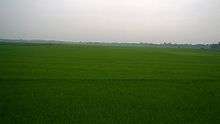
Rice was cultivated in the Indian subcontinent from as early as 5,000 BC.[62] "Several wild cereals, including rice, grew in the Vindhyan Hills, and rice cultivation, at sites such as Chopani-Mando and Mahagara, may have been underway as early as 7,000 BP. Rice appeared in the Belan and Ganges valley regions of northern India as early as 4530 BC and 5440 BC, respectively.[63] The early domestication process of rice in ancient India was based around the wild species Oryza nivara. This led to the local development of a mix of 'wetland' and 'dryland' agriculture of local Oryza sativa var. indica rice agriculture, before the truly 'wetland' rice Oryza sativa var. japonica, arrived around 2000 BC.[64]
Rice was cultivated in the Indus Valley civilization (3rd millennium BC).[65] Agricultural activity during the second millennium BC included rice cultivation in the Kashmir and Harrappan regions.[63] Mixed farming was the basis of Indus valley economy.[65]
O. sativa was recovered from a grave at Susa in Iran (dated to the first century AD) at one end of the ancient world, while at the same time rice was grown in the Po valley in Italy. In northern Iran, in Gilan province, many indica rice cultivars including 'Gerdeh', 'Hashemi', 'Hasani', and 'Gharib' have been bred by farmers.[66]
Other hypotheses
A 2012 study, through a map of genome variation in modern wild rice populations, indicated that the domestication of rice probably occurred around the central Pearl River valley region of southern China, in contradiction to archaeological evidence.[67] However, the study is based on modern distribution maps of wild rice populations which are potentially misleading due to drastic climatic changes that happened during the end of the last glacial period, ca. 12,000 years ago. Human activity over thousands of years have also removed populations of wild rice from their previous ranges. Based on Chinese texts, there were populations of wild rice along the Yangtze basin in c. AD 1,000 that are now recently extinct.[50]
An older theory, based on one chloroplast and two nuclear gene regions, Londo et al. (2006) had proposed that O. sativa rice was domesticated at least twice—indica in eastern India, Myanmar, and Thailand; and japonica in southern China and Vietnam—though they concede that archaeological and genetic evidence exist for a single domestication of rice in the lowlands of southern China.[68]
In 2003, Korean archaeologists alleged they discovered burnt grains of domesticated rice in Soro-ri, Korea, which dated to 13,000 BC. These antedate the oldest grains in China, which were dated to 10,000 BC, and potentially challenge the mainstream explanation that domesticated rice originated in China.[69] The findings were received by academia with strong skepticism at first,[70][71] but later accepted in secondary sources such as the archaeology text book Archaeology: Theories, Methods and Practice.[72]
Regional history
Africa
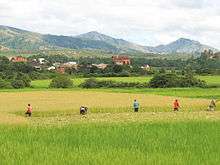
African rice has been cultivated for 3,500 years. Between 1500 and 800 BC, Oryza glaberrima propagated from its original centre, the Niger River delta, and extended to Senegal. However, it never developed far from its original region. Its cultivation even declined in favour of the Asian species, which was introduced to East Africa early in the common era and spread westward.[73]
Asia
Today, the majority of all rice produced comes from China, India, Indonesia, Bangladesh, Vietnam, Thailand, Myanmar, Pakistan, Philippines, Korea and Japan. Asian farmers still account for 87% of the world's total rice production. Because so much rice is produced in Bangladesh, it is also the staple food of the country.
Indonesia

Rice is a staple food for all classes in contemporary Indonesia,[74][75] and it holds the central place in Indonesian culture and Indonesian cuisine: it shapes the landscape; is sold at markets; and is served in most meals. Rice accounting for more than half of the calories in the average diet, and the source of livelihood for about 20 million households. The importance of rice in Indonesian culture is demonstrated through the reverence of Dewi Sri, the rice goddess of ancient Java and Bali.
Evidence of wild rice on the island of Sulawesi dates from 3000 BC. Historic written evidence for the earliest cultivation, however, comes from eighth century stone inscriptions from the central island of Java, which show kings levied taxes in rice. The images of rice cultivation, rice barn, and mouse pest investing a rice field is evident in Karmawibhangga bas-reliefs of Borobudur. Divisions of labour between men, women, and animals that are still in place in Indonesian rice cultivation, were carved into relief friezes on the ninth century Prambanan temples in Central Java: a water buffalo attached to a plough; women planting seedlings and pounding grain; and a man carrying sheaves of rice on each end of a pole across his shoulders (pikulan). In the sixteenth century, Europeans visiting the Indonesian islands saw rice as a new prestige food served to the aristocracy during ceremonies and feasts.[75]
Nepal
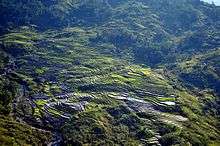
Rice is the major food amongst all the ethnic groups in Nepal. In the Terai, most rice varieties are cultivated during the rainy season. The principal rice growing season, known as "Berna-Bue Charne", is from June to July when water is sufficient for only a part of the fields; the subsidiary season, known as "Ropai, is from April to September, when there is usually enough water to sustain the cultivation of all rice fields. Farmers use irrigation channels throughout the cultivation seasons.
Philippines

The Banaue Rice Terraces (Filipino: Hagdan-hagdang Palayan ng Banawe) are 2,000-year-old terraces that were carved into the mountains of Ifugao in the Philippines by the ancestors of the Igorot people. The Rice Terraces are commonly referred to as the "Eighth Wonder of the World".[76][77][78] It is commonly thought that the terraces were built with minimal equipment, largely by hand. The terraces are located approximately 1,500 meters (5,000 ft) above sea level. They are fed by an ancient irrigation system from the rainforests above the terraces. It is said that if the steps were put end to end, it would encircle half the globe.[79] The terraces are found in the province of Ifugao and the Ifugao people have been its caretakers. Ifugao culture revolves[80] around rice and the culture displays an elaborate array of celebrations linked with agricultural rites from rice cultivation to rice consumption. The harvest season generally calls for thanksgiving feasts, while the concluding harvest rites called tango or tungul (a day of rest) entails a strict taboo on any agricultural work. Partaking of the bayah (rice beer), rice cakes, and betel nut constitutes an indelible practise during the festivities.
The Ifugao people practice traditional farming spending most of their labor at their terraces and forest lands while occasionally tending to root crop cultivation. The Ifugaos have also[79] been known to culture edible shells, fruit trees, and other vegetables which have been exhibited among Ifugaos for generations. The building of the rice terraces consists of blanketing walls with stones and earth which are designed to draw water from a main irrigation canal above the terrace clusters. Indigenous rice terracing technologies have been identified with the Ifugao's rice terraces such as their knowledge of water irrigation, stonework, earthwork and terrace maintenance. As their source of life and art, the rice terraces have sustained and shaped the lives of the community members.
Sri Lanka
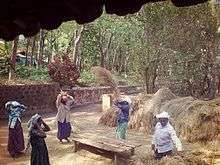
Rice is the staple food amongst all the ethnic groups in Sri Lanka. Agriculture in Sri Lanka mainly depends on the rice cultivation. Rice production is acutely dependent on rainfall and government supply necessity of water through irrigation channels throughout the cultivation seasons. The principal cultivation season, known as "Maha", is from October to March and the subsidiary cultivation season, known as "Yala", is from April to September. During Maha season, there is usually enough water to sustain the cultivation of all rice fields, nevertheless in Yala season there is only enough water for cultivation of half of the land extent. Traditional rice varieties are now making a comeback with the recent interest in green foods.
Thailand

Rice is the main export of Thailand, especially white jasmine rice 105 (Dok Mali 105).[81] Thailand has a large number of rice varieties, 3,500 kinds with different characters, and five kinds of wild rice cultivates.[82] In each region of the country there are different rice seed types. Their use depends on weather, atmosphere, and topography.[83]
The northern region has both low lands and high lands. The farmers' usual crop is non-glutinous rice[83] such as Niew Sun Pah Tong rice. This rice is naturally protected from leaf disease, and its paddy (unmilled rice) (Thai: ข้าวเปลือก) has a brown color.[84] The northeastern region is a large area where farmers can cultivate about 36 million square meters of rice. Although most of it is plains and dry areas,[85] white jasmine rice 105—the most famous Thai rice—can be grown there. White jasmine rice was developed in Chonburi Province first and after that grown in many areas in the country, but the rice from this region has a high quality, because it is softer, whiter, and more fragrant.[86] This rice can resist drought, acidic soil, and alkaline soil.[87]
The central region is mostly composed of plains. Most farmers grow Jao rice.[85] For example, Pathum Thani 1 rice which has qualities similar to white jasmine 105 rice. Its paddy has the color of thatch and the cooked rice has fragrant grains also.[88]
In the southern region, most farmers transplant around boundaries to the flood plains or on the plains between mountains. Farming in the region is slower than other regions because the rainy season comes later.[85] The popular rice varieties in this area are the Leb Nok Pattani seeds, a type of Jao rice. Its paddy has the color of thatch and it can be processed to make noodles.[89]
Companion plant
One of the earliest known examples of companion planting is the growing of rice with Azolla, the mosquito fern, which covers the top of a fresh rice paddy's water, blocking out any competing plants, as well as fixing nitrogen from the atmosphere for the rice to use. The rice is planted when it is tall enough to poke out above the azolla. This method has been used for at least a thousand years.
Middle East
Rice was grown in some areas of Mesopotamia (southern Iraq). With the rise of Islam it moved north to Nisibin, the southern shores of the Caspian Sea (in Gilan and Mazanderan provinces of Iran)[66] and then beyond the Muslim world into the valley of the Volga. In Egypt, rice is mainly grown in the Nile Delta. In Palestine, rice came to be grown in the Jordan Valley. Rice is also grown in Saudi Arabia at Al-Ahsa Oasis and in Yemen.[90]
Europe
Rice was known to the Classical world, being imported from Egypt, and perhaps west Asia. It was known to Greece (where it is still cultivated in Macedonia and Thrace) by returning soldiers from Alexander the Great's military expedition to Asia. Large deposits of rice from the first century AD have been found in Roman camps in Germany.[91]
The Moors brought Asiatic rice to the Iberian Peninsula in the 10th century. Records indicate it was grown in Valencia and Majorca. In Majorca, rice cultivation seems to have stopped after the Christian conquest, although historians are not certain.[90]
Muslims also brought rice to Sicily with cultivation starting in the 9th century,[92] where it was an important crop[90] long before it is noted in the plain of Pisa (1468) or in the Lombard plain (1475), where its cultivation was promoted by Ludovico Sforza, Duke of Milan, and demonstrated in his model farms.[93]
After the 15th century, rice spread throughout Italy and then France, later propagating to all the continents during the age of European exploration.
In European Russia, a short-grain, starchy rice similar to the Italian varieties, has been grown in the Krasnodar Krai, and known in Russia as "Kuban Rice" or "Krasnodar Rice". In the Russian Far East several japonica cultivars are grown in Primorye around the Khanka lake. Increasing scale of rice production in the region has recently brought criticism towards growers' alleged bad practices in regards to the environment.
Caribbean and Latin America
Most of the rice used today in the cuisine of the Americas is not native, but was introduced to Latin America and the Caribbean by European colonizers at an early date. However, there are at least two native (endemic) species of rice present in the Amazon region of South America, and one or both were used by the indigenous inhabitants of the region to create the domesticated form Oryza sp., some 4000 years ago.[94]
Spanish colonizers introduced Asian rice to Mexico in the 1520s at Veracruz, and the Portuguese and their African slaves introduced it at about the same time to colonial Brazil.[95] Recent scholarship suggests that enslaved Africans played an active role in the establishment of rice in the New World and that African rice was an important crop from an early period.[96] Varieties of rice and bean dishes that were a staple dish along the peoples of West Africa remained a staple among their descendants subjected to slavery in the Spanish New World colonies, Brazil and elsewhere in the Americas.[97]
North America
_(9684318485).jpg)
In 1694, rice arrived in South Carolina, probably originating from Madagascar.[95] Tradition (possibly apocryphal) has it that pirate John Thurber was returning from a slave-trading voyage to Madagascar when he was blown off course and put into Charleston for repairs. While there he gave a bag of seed rice to explorer Dr. Henry Woodward, who planted the rice and experimented with it until finding that it grew exceptionally well in the wet Carolina soil.[98][99]
The mastery of rice farming was a challenge for the English and other white settlers who were unfamiliar with the crop. Indians, who mostly gathering wild rice, were also inexperienced with rice cultivation. However, within the first fifty years of settlement rice became the dominant crop in South Carolina.[100]
In the United States, colonial South Carolina and Georgia grew and amassed great wealth from the slave labor obtained from the Senegambia area of West Africa and from coastal Sierra Leone. At the port of Charleston, through which 40% of all American slave imports passed, slaves from this region of Africa brought the highest prices due to their prior knowledge of rice culture, which was put to use on the many rice plantations around Georgetown, Charleston, and Savannah.
From the enslaved Africans, plantation owners learned how to dyke the marshes and periodically flood the fields. At first the rice was laboriously milled by hand using large mortars and pestles made of wood, then winnowed in sweetgrass baskets (the making of which was another skill brought by slaves from Africa). The invention of the rice mill increased profitability of the crop, and the addition of water power for the mills in 1787 by millwright Jonathan Lucas was another step forward.
Rice culture in the southeastern U.S. became less profitable with the loss of slave labor after the American Civil War, and it finally died out just after the turn of the 20th century. Today, people can visit the only remaining rice plantation in South Carolina that still has the original winnowing barn and rice mill from the mid-19th century at the historic Mansfield Plantation in Georgetown, South Carolina. The predominant strain of rice in the Carolinas was from Africa and was known as 'Carolina Gold'. The cultivar has been preserved and there are current attempts to reintroduce it as a commercially grown crop.[101]
In the southern United States, rice has been grown in southern Arkansas, Louisiana, and east Texas since the mid-19th century. Many Cajun farmers grew rice in wet marshes and low-lying prairies where they could also farm crayfish when the fields were flooded.[102] In recent years rice production has risen in North America, especially in the Mississippi embayment in the states of Arkansas and Mississippi (see also Arkansas Delta and Mississippi Delta).
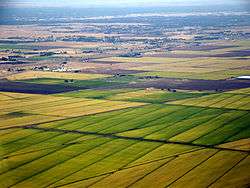
Rice cultivation began in California during the California Gold Rush, when an estimated 40,000 Chinese laborers immigrated to the state and grew small amounts of the grain for their own consumption. However, commercial production began only in 1912 in the town of Richvale in Butte County.[103] By 2006, California produced the second-largest rice crop in the United States,[104] after Arkansas, with production concentrated in six counties north of Sacramento.[105] Unlike the Arkansas–Mississippi Delta region, California's production is dominated by short- and medium-grain japonica varieties, including cultivars developed for the local climate such as Calrose, which makes up as much as 85% of the state's crop.[106]
References to "wild rice" native to North America are to the unrelated Zizania palustris.[107]
More than 100 varieties of rice are commercially produced primarily in six states (Arkansas, Texas, Louisiana, Mississippi, Missouri, and California) in the U.S.[108] According to estimates for the 2006 crop year, rice production in the U.S. is valued at $1.88 billion, approximately half of which is expected to be exported. The U.S. provides about 12% of world rice trade.[108] The majority of domestic utilization of U.S. rice is direct food use (58%), while 16% is used in each of processed foods and beer. 10% is found in pet food.[108]
Oceania
Rice was one of the earliest crops planted in Australia by British settlers, who had experience with rice plantations in the Americas and India.
Although attempts to grow rice in the well-watered north of Australia have been made for many years, they have consistently failed because of inherent iron and manganese toxicities in the soils and destruction by pests.
In the 1920s, it was seen as a possible irrigation crop on soils within the Murray–Darling basin that were too heavy for the cultivation of fruit and too infertile for wheat.[109]
Because irrigation water, despite the extremely low runoff of temperate Australia,[110] was (and remains) very cheap, the growing of rice was taken up by agricultural groups over the following decades. Californian varieties of rice were found suitable for the climate in the Riverina,[109] and the first mill opened at Leeton in 1951.
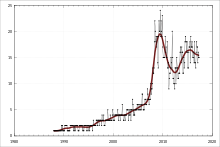
Even before this Australia's rice production greatly exceeded local needs,[109] and rice exports to Japan have become a major source of foreign currency. Above-average rainfall from the 1950s to the middle 1990s[111] encouraged the expansion of the Riverina rice industry, but its prodigious water use in a practically waterless region began to attract the attention of environmental scientists. These became severely concerned with declining flow in the Snowy River and the lower Murray River.
Although rice growing in Australia is highly profitable due to the cheapness of land, several recent years of severe drought have led many to call for its elimination because of its effects on extremely fragile aquatic ecosystems. The Australian rice industry is somewhat opportunistic, with the area planted varying significantly from season to season depending on water allocations in the Murray and Murrumbidgee irrigation regions.
Australian Aboriginal people have harvested native rice varieties for thousands of years, and there are ongoing efforts to grow commercial quantities of these species.[112][113]
Production and commerce
| Rice production – 2018 | |
|---|---|
| Country | millions of tonnes |
| 212.1 | |
| 172.6 | |
| 83.0 | |
| 56.4 | |
| 44.0 | |
| 32.2 | |
| 25.4 | |
| 19.1 | |
| 11.7 | |
| 10.8 | |
| World | 688.2 |
| Source: FAOSTAT of the United Nations[1] | |
Production
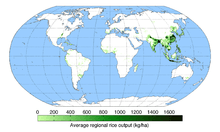
.jpg)
In 2017, world production of paddy rice was 769.7 million tonnes,[114] led by China and India with a combined 49% of this total.[1] Other major producers were Indonesia, Bangladesh and Vietnam. The five major producers accounted for 72% of total production, while the top fifteen producers accounted for 91% of total world production in 2017 (see table on right). Developing countries account for 95% of the total production.[115]
Rice is a major food staple and a mainstay for the rural population and their food security. It is mainly cultivated by small farmers in holdings of less than one hectare. Rice is also a wage commodity for workers in the cash crop or non-agricultural sectors. Rice is vital for the nutrition of much of the population in Asia, as well as in Latin America and the Caribbean and in Africa; it is central to the food security of over half the world population.
Many rice grain producing countries have significant losses post-harvest at the farm and because of poor roads, inadequate storage technologies, inefficient supply chains and farmer's inability to bring the produce into retail markets dominated by small shopkeepers. A World Bank – FAO study claims 8% to 26% of rice is lost in developing nations, on average, every year, because of post-harvest problems and poor infrastructure. Some sources claim the post-harvest losses exceed 40%.[115][116] Not only do these losses reduce food security in the world, the study claims that farmers in developing countries such as China, India and others lose approximately US$89 billion of income in preventable post-harvest farm losses, poor transport, the lack of proper storage and retail. One study claims that if these post-harvest grain losses could be eliminated with better infrastructure and retail network, in India alone enough food would be saved every year to feed 70 to 100 million people.[117]
Processing
The seeds of the rice plant are first milled using a rice huller to remove the chaff (the outer husks of the grain) (see: rice hulls). At this point in the process, the product is called brown rice. The milling may be continued, removing the bran, i.e., the rest of the husk and the germ, thereby creating white rice. White rice, which keeps longer, lacks some important nutrients; moreover, in a limited diet which does not supplement the rice, brown rice helps to prevent the disease beriberi.
Either by hand or in a rice polisher, white rice may be buffed with glucose or talc powder (often called polished rice, though this term may also refer to white rice in general), parboiled, or processed into flour. White rice may also be enriched by adding nutrients, especially those lost during the milling process. While the cheapest method of enriching involves adding a powdered blend of nutrients that will easily wash off (in the United States, rice which has been so treated requires a label warning against rinsing), more sophisticated methods apply nutrients directly to the grain, coating the grain with a water-insoluble substance which is resistant to washing.
In some countries, a popular form, parboiled rice (also known as converted rice and easy-cook rice[118]) is subjected to a steaming or parboiling process while still a brown rice grain. The parboil process causes a gelatinisation of the starch in the grains. The grains become less brittle, and the color of the milled grain changes from white to yellow. The rice is then dried, and can then be milled as usual or used as brown rice. Milled parboiled rice is nutritionally superior to standard milled rice, because the process causes nutrients from the outer husk (especially thiamine) to move into the endosperm, so that less is subsequently lost when the husk is polished off during milling. Parboiled rice has an additional benefit in that it does not stick to the pan during cooking, as happens when cooking regular white rice. This type of rice is eaten in parts of India and countries of West Africa are also accustomed to consuming parboiled rice.
Rice bran, called nuka in Japan, is a valuable commodity in Asia and is used for many daily needs. It is a moist, oily inner layer which is heated to produce oil. It is also used as a pickling bed in making rice bran pickles and takuan.
Raw rice may be ground into flour for many uses, including making many kinds of beverages, such as amazake, horchata, rice milk, and rice wine. Rice does not contain gluten, so is suitable for people on a gluten-free diet.[119] Rice may also be made into various types of noodles. Raw, wild, or brown rice may also be consumed by raw-foodist or fruitarians if soaked and sprouted (usually a week to 30 days – gaba rice).
Processed rice seeds must be boiled or steamed before eating. Boiled rice may be further fried in cooking oil or butter (known as fried rice), or beaten in a tub to make mochi.
Rice is a good source of protein and a staple food in many parts of the world, but it is not a complete protein: it does not contain all of the essential amino acids in sufficient amounts for good health, and should be combined with other sources of protein, such as nuts, seeds, beans, fish, or meat.[120]
Rice, like other cereal grains, can be puffed (or popped). This process takes advantage of the grains' water content and typically involves heating grains in a special chamber. Further puffing is sometimes accomplished by processing puffed pellets in a low-pressure chamber. The ideal gas law means either lowering the local pressure or raising the water temperature results in an increase in volume prior to water evaporation, resulting in a puffy texture. Bulk raw rice density is about 0.9 g/cm³. It decreases to less than one-tenth that when puffed.
Harvesting, drying and milling
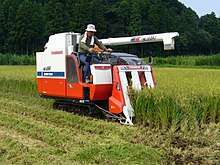
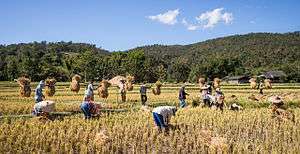
Unmilled rice, known as "paddy" (Indonesia and Malaysia: padi; Philippines, palay), is usually harvested when the grains have a moisture content of around 25%. In most Asian countries, where rice is almost entirely the product of smallholder agriculture, harvesting is carried out manually, although there is a growing interest in mechanical harvesting. Harvesting can be carried out by the farmers themselves, but is also frequently done by seasonal labor groups. Harvesting is followed by threshing, either immediately or within a day or two. Again, much threshing is still carried out by hand but there is an increasing use of mechanical threshers. Subsequently, paddy needs to be dried to bring down the moisture content to no more than 20% for milling.
A familiar sight in several Asian countries is paddy laid out to dry along roads. However, in most countries the bulk of drying of marketed paddy takes place in mills, with village-level drying being used for paddy to be consumed by farm families. Mills either sun dry or use mechanical driers or both. Drying has to be carried out quickly to avoid the formation of molds. Mills range from simple hullers, with a throughput of a couple of tonnes a day, that simply remove the outer husk, to enormous operations that can process 4,000 tonnes a day and produce highly polished rice. A good mill can achieve a paddy-to-rice conversion rate of up to 72% but smaller, inefficient mills often struggle to achieve 60%. These smaller mills often do not buy paddy and sell rice but only service farmers who want to mill their paddy for their own consumption.
Distribution
Because of the importance of rice to human nutrition and food security in Asia, the domestic rice markets tend to be subject to considerable state involvement. While the private sector plays a leading role in most countries, agencies such as BULOG in Indonesia, the NFA in the Philippines, VINAFOOD in Vietnam and the Food Corporation of India are all heavily involved in purchasing of paddy from farmers or rice from mills and in distributing rice to poorer people. BULOG and NFA monopolise rice imports into their countries while VINAFOOD controls all exports from Vietnam.[121]
Trade
World trade figures are very different from those for production, as less than 8% of rice produced is traded internationally.[122] In economic terms, the global rice trade was a small fraction of 1% of world mercantile trade. Many countries consider rice as a strategic food staple, and various governments subject its trade to a wide range of controls and interventions.
Developing countries are the main players in the world rice trade, accounting for 83% of exports and 85% of imports. While there are numerous importers of rice, the exporters of rice are limited. Just five countries—Thailand, Vietnam, China, the United States and India—in decreasing order of exported quantities, accounted for about three-quarters of world rice exports in 2002.[115] However, this ranking has been rapidly changing in recent years. In 2010, the three largest exporters of rice, in decreasing order of quantity exported were Thailand, Vietnam and India. By 2012, India became the largest exporter of rice with a 100% increase in its exports on year-to-year basis, and Thailand slipped to third position.[123][124] Together, Thailand, Vietnam and India accounted for nearly 70% of the world rice exports.
The primary variety exported by Thailand and Vietnam were Jasmine rice, while exports from India included aromatic Basmati variety. China, an exporter of rice in early 2000s, was a net importer of rice in 2010 and will become the largest net importer, surpassing Nigeria, in 2013.[122][125] According to a USDA report, the world's largest exporters of rice in 2012 were India (9.75 million tonnes), Vietnam (7 million tonnes), Thailand (6.5 million tonnes), Pakistan (3.75 million tonnes) and the United States (3.5 million tonnes).[126]
Major importers usually include Nigeria, Indonesia, Bangladesh, Saudi Arabia, Iran, Iraq, Malaysia, the Philippines, Brazil and some African and Persian Gulf countries. In common with other West African countries, Nigeria is actively promoting domestic production. However, its very heavy import duties (110%) open it to smuggling from neighboring countries.[127] Parboiled rice is particularly popular in Nigeria. Although China and India are the two largest producers of rice in the world, both countries consume the majority of the rice produced domestically, leaving little to be traded internationally.
World's most productive rice farms and farmers
The average world yield for rice was 4.3 tonnes per hectare, in 2010.
Australian rice farms were the most productive in 2010, with a nationwide average of 10.8 tonnes per hectare.[128]
Yuan Longping of China National Hybrid Rice Research and Development Center, China, set a world record for rice yield in 2010 at 19 tonnes per hectare on a demonstration plot. In 2011, this record was surpassed by an Indian farmer, Sumant Kumar, with 22.4 tonnes per hectare in Bihar. Both these farmers claim to have employed newly developed rice breeds and System of Rice Intensification (SRI), a recent innovation in rice farming. SRI is claimed to have set new national records in rice yields, within the last 10 years, in many countries. The claimed Chinese and Indian yields have yet to be demonstrated on seven-hectare lots and to be reproducible over two consecutive years on the same farm.[129][130][131][132]
Price
In late 2007 to May 2008, the price of grains rose greatly due to droughts in major producing countries (particularly Australia), increased use of grains for animal feed and US subsidies for bio-fuel production. Although there was no shortage of rice on world markets this general upward trend in grain prices led to panic buying by consumers, government rice export bans (in particular, by Vietnam and India) and inflated import orders by the Philippines marketing board, the National Food Authority. This caused significant rises in rice prices. In late April 2008, prices hit 24 US cents a pound, twice the price of seven months earlier.[133] Over the period of 2007 to 2013, the Chinese government has substantially increased the price it pays domestic farmers for their rice, rising to US$500 per metric ton by 2013.[122] The 2013 price of rice originating from other southeast Asian countries was a comparably low US$350 per metric ton.[122]
On April 30, 2008, Thailand announced plans for the creation of the Organisation of Rice Exporting Countries (OREC) with the intention that this should develop into a price-fixing cartel for rice.[134][135] However, as of mid-2011 little progress had been made to achieve this.
Worldwide consumption
| Food consumption of rice in 2013 (millions of metric tons of paddy equivalent)[136] | |
|---|---|
| 162.4 | |
| 130.4 | |
| 50.4 | |
| 40.3 | |
| 19.9 | |
| 17.6 | |
| 11.5 | |
| 11.4 | |
As of 2013, world food consumption of rice was 565.6 million metric tons of paddy equivalent (377,283 of milled equivalent), while the largest consumers were China consuming 162.4 million metric tons of paddy equivalent (28.7% of world consumption) and India consuming 130.4 million metric tons of paddy equivalent (23.1% of world consumption).[136]
Between 1961 and 2002, per capita consumption of rice increased by 40%.
Rice is the most important crop in Asia. In Cambodia, for example, 90% of the total agricultural area is used for rice production.[137]
U.S. rice consumption has risen sharply over the past 25 years, fueled in part by commercial applications such as beer production.[138] Almost one in five adult Americans now report eating at least half a serving of white or brown rice per day.[139]
Environmental impacts
.jpg)
Rice cultivation on wetland rice fields is thought to be responsible for 11% of the anthropogenic methane emissions.[140] Rice requires slightly more water to produce than other grains.[141] Rice production uses almost a third of Earth's fresh water.[142]
Long-term flooding of rice fields cuts the soil off from atmospheric oxygen and causes anaerobic fermentation of organic matter in the soil.[143] Methane production from rice cultivation contributes ~1.5% of anthropogenic greenhouse gases.[144] Methane is twenty times more potent a greenhouse gas than carbon dioxide.[145]
A 2010 study found that, as a result of rising temperatures and decreasing solar radiation during the later years of the 20th century, the rice yield growth rate has decreased in many parts of Asia, compared to what would have been observed had the temperature and solar radiation trends not occurred.[146][147] The yield growth rate had fallen 10–20% at some locations. The study was based on records from 227 farms in Thailand, Vietnam, Nepal, India, China, Bangladesh, and Pakistan. The mechanism of this falling yield was not clear, but might involve increased respiration during warm nights, which expends energy without being able to photosynthesize.
Rainfall
Temperature
Rice requires high temperature above 20 °C (68 °F) but not more than 35 to 40 °C (95 to 104 °F). Optimum temperature is around 30 °C (Tmax) and 20 °C (Tmin).[148]
Solar radiation
The amount of solar radiation received during the 45 days leading up to harvest determines final crop output.[148]
Atmospheric water vapor
High water vapor content (in humid tropics) subjects unusual stress which favors the spread of fungal and bacterial diseases.[148]
Wind
Light wind transports CO2 to the leaf canopy but strong wind causes severe damage and may lead to sterility (due to pollen dehydration, spikelet sterility, and abortive endosperms).[148]
Pests and diseases
Rice pests are any organisms or microbes with the potential to reduce the yield or value of the rice crop (or of rice seeds).[149] Rice pests include weeds, pathogens, insects, nematode, rodents, and birds. A variety of factors can contribute to pest outbreaks, including climatic factors, improper irrigation, the overuse of insecticides and high rates of nitrogen fertilizer application.[150] Weather conditions also contribute to pest outbreaks. For example, rice gall midge and army worm outbreaks tend to follow periods of high rainfall early in the wet season, while thrips outbreaks are associated with drought.[151]
Insects
Major rice insect pests include: the brown planthopper (BPH),[152] several spp. of stemborers—including those in the genera Scirpophaga and Chilo,[153] the rice gall midge,[154] several spp. of rice bugs,[155] notably in the genus Leptocorisa,[156] defoliators such as the rice: leafroller, hispa and grasshoppers.[157] The fall army worm, a species of Lepidoptera, also targets and causes damage to rice crops.[158] Rice weevils attack stored produce.
Diseases
Rice blast, caused by the fungus Magnaporthe grisea,[159] is the most significant disease affecting rice cultivation. Other major rice diseases include: sheath blight (caused by Rhizoctonia solani), rice ragged stunt (vector: BPH), and tungro (vector: Nephotettix spp).[160] There is also an ascomycete fungus, Cochliobolus miyabeanus, that causes brown spot disease in rice.[161][162]
Nematodes
Several nematode species infect rice crops, causing diseases such as Ufra (Ditylenchus dipsaci), White tip disease (Aphelenchoide bessei), and root knot disease (Meloidogyne graminicola). Some nematode species such as Pratylenchus spp. are most dangerous in upland rice of all parts of the world. Rice root nematode (Hirschmanniella oryzae) is a migratory endoparasite which on higher inoculum levels will lead to complete destruction of a rice crop. Beyond being obligate parasites, they also decrease the vigor of plants and increase the plants' susceptibility to other pests and diseases.
Other pests
These include the apple snail Pomacea canaliculata, panicle rice mite, rats,[163] and the weed Echinochloa crusgali.[164]
Integrated pest management
Crop protection scientists are trying to develop rice pest management techniques which are sustainable. In other words, to manage crop pests in such a manner that future crop production is not threatened.[165] Sustainable pest management is based on four principles: biodiversity, host plant resistance (HPR), landscape ecology, and hierarchies in a landscape—from biological to social.[166] At present, rice pest management includes cultural techniques, pest-resistant rice varieties, and pesticides (which include insecticide). Increasingly, there is evidence that farmers' pesticide applications are often unnecessary, and even facilitate pest outbreaks.[167][168][169][170] By reducing the populations of natural enemies of rice pests,[171] misuse of insecticides can actually lead to pest outbreaks.[172] The International Rice Research Institute (IRRI) demonstrated in 1993 that an 87.5% reduction in pesticide use can lead to an overall drop in pest numbers.[173] IRRI also conducted two campaigns in 1994 and 2003, respectively, which discouraged insecticide misuse and smarter pest management in Vietnam.[174][175]
Rice plants produce their own chemical defenses to protect themselves from pest attacks. Some synthetic chemicals, such as the herbicide 2,4-D, cause the plant to increase the production of certain defensive chemicals and thereby increase the plant's resistance to some types of pests.[176] Conversely, other chemicals, such as the insecticide imidacloprid, can induce changes in the gene expression of the rice that cause the plant to become more susceptible to attacks by certain types of pests.[177] 5-Alkylresorcinols are chemicals that can also be found in rice.[178]
Botanicals, so-called "natural pesticides", are used by some farmers in an attempt to control rice pests. Botanicals include extracts of leaves, or a mulch of the leaves themselves. Some upland rice farmers in Cambodia spread chopped leaves of the bitter bush (Chromolaena odorata) over the surface of fields after planting. This practice probably helps the soil retain moisture and thereby facilitates seed germination. Farmers also claim the leaves are a natural fertilizer and helps suppress weed and insect infestations.[179]
Among rice cultivars, there are differences in the responses to, and recovery from, pest damage.[155][180] Many rice varieties have been selected for resistance to insect pests.[181][182] Therefore, particular cultivars are recommended for areas prone to certain pest problems. The genetically based ability of a rice variety to withstand pest attacks is called resistance. Three main types of plant resistance to pests are recognized as nonpreference, antibiosis, and tolerance.[183] Nonpreference (or antixenosis) describes host plants which insects prefer to avoid; antibiosis is where insect survival is reduced after the ingestion of host tissue; and tolerance is the capacity of a plant to produce high yield or retain high quality despite insect infestation.[184]
Over time, the use of pest-resistant rice varieties selects for pests that are able to overcome these mechanisms of resistance. When a rice variety is no longer able to resist pest infestations, resistance is said to have broken down. Rice varieties that can be widely grown for many years in the presence of pests and retain their ability to withstand the pests are said to have durable resistance. Mutants of popular rice varieties are regularly screened by plant breeders to discover new sources of durable resistance.[183][185]
Parasitic weeds
Rice is parasitized by the weed eudicot Striga hermonthica,[186] which is of local importance for this crop.
Ecotypes and cultivars

While most rice is bred for crop quality and productivity, there are varieties selected for characteristics such as texture, smell, and firmness. There are four major categories of rice worldwide: indica, japonica, aromatic and glutinous. The different varieties of rice are not considered interchangeable, either in food preparation or agriculture, so as a result, each major variety is a completely separate market from other varieties. It is common for one variety of rice to rise in price while another one drops in price.[187]
Rice cultivars also fall into groups according to environmental conditions, season of planting, and season of harvest, called ecotypes. Some major groups are the Japan-type (grown in Japan), "buly" and "tjereh" types (Indonesia); sali (or aman—main winter crop), ahu (also aush or ghariya, summer), and boro (spring) (Bengal and Assam).[188][189] Cultivars exist that are adapted to deep flooding, and these are generally called "floating rice".[190]
The largest collection of rice cultivars is at the International Rice Research Institute[191] in the Philippines, with over 100,000 rice accessions[192] held in the International Rice Genebank.[193] Rice cultivars are often classified by their grain shapes and texture. For example, Thai Jasmine rice is long-grain and relatively less sticky, as some long-grain rice contains less amylopectin than short-grain cultivars. Chinese restaurants often serve long-grain as plain unseasoned steamed rice though short-grain rice is common as well. Japanese mochi rice and Chinese sticky rice are short-grain. Chinese people use sticky rice which is properly known as "glutinous rice" (note: glutinous refer to the glue-like characteristic of rice; does not refer to "gluten") to make zongzi. The Japanese table rice is a sticky, short-grain rice. Japanese sake rice is another kind as well.
Indian rice cultivars include long-grained and aromatic Basmati (ਬਾਸਮਤੀ) (grown in the North), long and medium-grained Patna rice, and in South India (Andhra Pradesh and Karnataka) short-grained Sona Masuri (also called as Bangaru theegalu). In the state of Tamil Nadu, the most prized cultivar is ponni which is primarily grown in the delta regions of the Kaveri River. Kaveri is also referred to as ponni in the South and the name reflects the geographic region where it is grown. In the Western Indian state of Maharashtra, a short grain variety called Ambemohar is very popular. This rice has a characteristic fragrance of Mango blossom.
Aromatic rices have definite aromas and flavors; the most noted cultivars are Thai fragrant rice, Basmati, Patna rice, Vietnamese fragrant rice, and a hybrid cultivar from America, sold under the trade name Texmati. Both Basmati and Texmati have a mild popcorn-like aroma and flavor. In Indonesia, there are also red and black cultivars.
High-yield cultivars of rice suitable for cultivation in Africa and other dry ecosystems, called the new rice for Africa (NERICA) cultivars, have been developed. It is hoped that their cultivation will improve food security in West Africa.
Draft genomes for the two most common rice cultivars, indica and japonica, were published in April 2002. Rice was chosen as a model organism for the biology of grasses because of its relatively small genome (~430 megabase pairs). Rice was the first crop with a complete genome sequence.[194]
On December 16, 2002, the UN General Assembly declared the year 2004 the International Year of Rice. The declaration was sponsored by more than 40 countries.
Biotechnology
High-yielding varieties
The high-yielding varieties are a group of crops created intentionally during the Green Revolution to increase global food production. This project enabled labor markets in Asia to shift away from agriculture, and into industrial sectors. The first "Rice Car", IR8 was produced in 1966 at the International Rice Research Institute which is based in the Philippines at the University of the Philippines' Los Baños site. IR8 was created through a cross between an Indonesian variety named "Peta" and a Chinese variety named "Dee Geo Woo Gen."[195]
Scientists have identified and cloned many genes involved in the gibberellin signaling pathway, including GAI1 (Gibberellin Insensitive) and SLR1 (Slender Rice).[196] Disruption of gibberellin signaling can lead to significantly reduced stem growth leading to a dwarf phenotype. Photosynthetic investment in the stem is reduced dramatically as the shorter plants are inherently more stable mechanically. Assimilates become redirected to grain production, amplifying in particular the effect of chemical fertilizers on commercial yield. In the presence of nitrogen fertilizers, and intensive crop management, these varieties increase their yield two to three times.
Future potential
As the UN Millennium Development project seeks to spread global economic development to Africa, the "Green Revolution" is cited as the model for economic development. With the intent of replicating the successful Asian boom in agronomic productivity, groups like the Earth Institute are doing research on African agricultural systems, hoping to increase productivity. An important way this can happen is the production of "New Rices for Africa" (NERICA). These rices, selected to tolerate the low input and harsh growing conditions of African agriculture, are produced by the African Rice Center, and billed as technology "from Africa, for Africa". The NERICA have appeared in The New York Times (October 10, 2007) and International Herald Tribune (October 9, 2007), trumpeted as miracle crops that will dramatically increase rice yield in Africa and enable an economic resurgence. Ongoing research in China to develop perennial rice could result in enhanced sustainability and food security.
Golden rice
Rice kernels do not contain vitamin A, so people who obtain most of their calories from rice are at risk of vitamin A deficiency. German and Swiss researchers have genetically engineered rice to produce beta-carotene, the precursor to vitamin A, in the rice kernel. The beta-carotene turns the processed (white) rice a "gold" color, hence the name "golden rice." The beta-carotene is converted to vitamin A in humans who consume the rice.[197] Although some rice strains produce beta-carotene in the hull, no non-genetically engineered strains have been found that produce beta-carotene in the kernel, despite the testing of thousands of strains. Additional efforts are being made to improve the quantity and quality of other nutrients in golden rice.[198]
The International Rice Research Institute is currently further developing and evaluating Golden Rice as a potential new way to help address vitamin A deficiency.[199]
Expression of human proteins
Ventria Bioscience has genetically modified rice to express lactoferrin, lysozyme which are proteins usually found in breast milk, and human serum albumin, These proteins have antiviral, antibacterial, and antifungal effects.[200]
Rice containing these added proteins can be used as a component in oral rehydration solutions which are used to treat diarrheal diseases, thereby shortening their duration and reducing recurrence. Such supplements may also help reverse anemia.[201]
Flood-tolerant rice
Due to the varying levels that water can reach in regions of cultivation, flood tolerant varieties have long been developed and used. Flooding is an issue that many rice growers face, especially in South and South East Asia where flooding annually affects 20 million hectares.[202] Standard rice varieties cannot withstand stagnant flooding of more than about a week,[203] mainly as it disallows the plant access to necessary requirements such as sunlight and essential gas exchanges, inevitably leading to plants being unable to recover.[202] In the past, this has led to massive losses in yields, such as in the Philippines, where in 2006, rice crops worth $65 million were lost to flooding.[204] Recently developed cultivars seek to improve flood tolerance.
Drought-tolerant rice
Drought represents a significant environmental stress for rice production, with 19–23 million hectares of rainfed rice production in South and South East Asia often at risk.[205][206] Under drought conditions, without sufficient water to afford them the ability to obtain the required levels of nutrients from the soil, conventional commercial rice varieties can be severely affected—for example, yield losses as high as 40% have affected some parts of India, with resulting losses of around US$800 million annually.[207]
The International Rice Research Institute conducts research into developing drought-tolerant rice varieties, including the varieties 5411 and Sookha dhan, currently being employed by farmers in the Philippines and Nepal respectively.[206] In addition, in 2013 the Japanese National Institute for Agrobiological Sciences led a team which successfully inserted the DEEPER ROOTING 1 (DRO1) gene, from the Philippine upland rice variety Kinandang Patong, into the popular commercial rice variety IR64, giving rise to a far deeper root system in the resulting plants.[207] This facilitates an improved ability for the rice plant to derive its required nutrients in times of drought via accessing deeper layers of soil, a feature demonstrated by trials which saw the IR64 + DRO1 rice yields drop by 10% under moderate drought conditions, compared to 60% for the unmodified IR64 variety.[207][208]
Salt-tolerant rice
Soil salinity poses a major threat to rice crop productivity, particularly along low-lying coastal areas during the dry season.[205] For example, roughly 1 million hectares of the coastal areas of Bangladesh are affected by saline soils.[209] These high concentrations of salt can severely affect rice plants' normal physiology, especially during early stages of growth, and as such farmers are often forced to abandon these otherwise potentially usable areas.[210][211]
Progress has been made, however, in developing rice varieties capable of tolerating such conditions; the hybrid created from the cross between the commercial rice variety IR56 and the wild rice species Oryza coarctata is one example.[212] O. coarctata is capable of successful growth in soils with double the limit of salinity of normal varieties, but lacks the ability to produce edible rice.[212] Developed by the International Rice Research Institute, the hybrid variety can utilise specialised leaf glands that allow for the removal of salt into the atmosphere. It was initially produced from one successful embryo out of 34,000 crosses between the two species; this was then backcrossed to IR56 with the aim of preserving the genes responsible for salt tolerance that were inherited from O. coarctata.[210] Extensive trials are planned prior to the new variety being available to farmers by approximately 2017–18.[210]
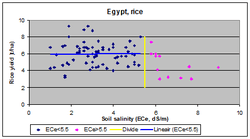
When the problem of soil salinity arises it will be opportune to select salt tolerant varieties (IRRI[214] or to resort to soil salinity control.
Soil salinity is often measured as the electric conductivity (EC) of the extract of a saturated soil paste (ECe). The EC units are usually expressed in millimho/cm or dS/m. The critical ECe value of 5.5 dS/m in the figure, obtained from measurements in farmers' fields, indicates that the rice crop is slightly salt sensitive.
Environment-friendly rice
Producing rice in paddies is harmful for the environment due to the release of methane by methanogenic bacteria. These bacteria live in the anaerobic waterlogged soil, and live off nutrients released by rice roots. Researchers have recently reported in Nature that putting the barley gene SUSIBA2 into rice creates a shift in biomass production from root to shoot (above ground tissue becomes larger, while below ground tissue is reduced), decreasing the methanogen population, and resulting in a reduction of methane emissions of up to 97%. Apart from this environmental benefit, the modification also increases the amount of rice grains by 43%, which makes it a useful tool in feeding a growing world population.[215][216]
Meiosis and DNA repair
Rice is used as a model organism for investigating the molecular mechanisms of meiosis and DNA repair in higher plants. Meiosis is a key stage of the sexual cycle in which diploid cells in the ovule (female structure) and the anther (male structure) produce haploid cells that develop further into gametophytes and gametes. So far, 28 meiotic genes of rice have been characterized.[217] Studies of rice gene OsRAD51C showed that this gene is necessary for homologous recombinational repair of DNA, particularly the accurate repair of DNA double-strand breaks during meiosis.[218] Rice gene OsDMC1 was found to be essential for pairing of homologous chromosomes during meiosis,[219] and rice gene OsMRE11 was found to be required for both synapsis of homologous chromosomes and repair of double-strand breaks during meiosis.[220]
Cultural roles of rice

Rice plays an important role in certain religions and popular beliefs. In many cultures relatives will scatter rice during or towards the end of a wedding ceremony in front of the bride and groom.[221]
The pounded rice ritual is conducted during weddings in Nepal. The bride gives a leafplate full of pounded rice to the groom after he requests it politely from her.[222]
In the Philippines rice wine, popularly known as tapuy, is used for important occasions such as weddings, rice harvesting ceremonies and other celebrations.[223]
Dewi Sri is the traditional rice goddess of the Javanese, Sundanese, and Balinese people in Indonesia. Most rituals involving Dewi Sri are associated with the mythical origin attributed to the rice plant, the staple food of the region.[224][225] In Thailand, a similar rice deity is known as Phosop; she is a deity more related to ancient local folklore than a goddess of a structured, mainstream religion.[226] The same female rice deity is known as Po Ino Nogar in Cambodia and as Nang Khosop in Laos. Ritual offerings are made during the different stages of rice production to propitiate the Rice Goddess in the corresponding cultures.
A 2014 study of Han Chinese communities found that a history of farming rice makes cultures more psychologically interdependent, whereas a history of farming wheat makes cultures more independent.[227]
A Royal Ploughing Ceremony is held in certain Asian countries to mark the beginning of the rice planting season. It is still honored in the kingdoms of Cambodia and Thailand.
See also
- Artificial rice
- Rice production
- Glutinous rice
- Indonesian rice table
- List of dried foods
- List of rice dishes
- List of rice varieties
- Maratelli rice
- Mushroom production on rice straw
- Post-harvest losses
- Puffed rice
- Rice Belt
- Rice bran oil
- Rice bread
- Rice wine
- Rice writing
- Risotto
- Straw
- System of Rice Intensification
- Texas rice production
- Upland rice
- Wild rice
References
- "Crops/Regions/World list/Production Quantity (pick lists), Rice (paddy), 2018". UN Food and Agriculture Organization, Corporate Statistical Database (FAOSTAT). 2020. Archived from the original on May 11, 2017. Retrieved October 11, 2019.
- Smith, Bruce D. (1998) The Emergence of Agriculture. Scientific American Library, A Division of HPHLP, New York, ISBN 0-7167-6030-4.
- "The Rice Plant and How it Grows". International Rice Research Institute. Archived from the original on January 6, 2009.
- rice Archived June 6, 2011, at the Wayback Machine, Online Etymology Dictionary
- "rice". Oxford Dictionaries (English, online ed.). Archived from the original on March 13, 2014. Retrieved March 13, 2014.
- ὄρυζα Archived March 16, 2012, at the Wayback Machine, Henry George Liddell, Robert Scott, A Greek-English Lexicon, on Perseus
- Witzel, Michael (1999). "Substrate Languages in Old Indo-Aryan" (PDF). Electronic Journal of Vedic Studies. 5 (1): 26. Archived from the original (PDF) on February 6, 2012.
- Thorley, John (1969). "The development of trade between the Roman Empire and the East under Augustus". Greece & Rome. 16 (2): 209–23. doi:10.1017/S001738350001706X. JSTOR 642851.
- Witzel, Michael (2009). "The linguistic history of some Indian domestic plants". Journal of Biosciences. 34 (6): 829–33. doi:10.1007/s12038-009-0096-1. PMID 20093735. S2CID 6245657. Archived from the original on April 3, 2013.
- Mayrhofer, Manfred (1996). Etymologisches Wörterbuch des Altindoarischen (in German). 2. Heidelberg: Universitätsverlag Winter. p. 598. ISBN 978-3-8253-4550-1.
- "Rice originated in India". www.downtoearth.org.in. Retrieved June 7, 2020.
- UCL (July 5, 2018). "Debating the Origins of Rice". Rice. Retrieved June 7, 2020.
- Huang, Xuehui; Kurata, Nori; Wei, Xinghua; Wang, Zi-Xuan; Wang, Ahong; Zhao, Qiang; Zhao, Yan; Liu, Kunyan; Lu, Hengyun; Li, Wenjun; Guo, Yunli (October 2012). "A map of rice genome variation reveals the origin of cultivated rice". Nature. 490 (7421): 497–501. Bibcode:2012Natur.490..497H. doi:10.1038/nature11532. ISSN 1476-4687. PMID 23034647.
- Thakur, Biswajeet; Saxena, Anju; Singh, I (June 5, 2018). "Paddy cultivation during early Holocene: Evidence from diatoms in Lahuradewa lake sediments, Ganga Plain". Current Science. 114. doi:10.18520/cs/v114/i10/2106-2115.
- Bates, J.; Petrie, C. A.; Singh, R. N. (February 1, 2017). "Approaching rice domestication in South Asia: New evidence from Indus settlements in northern India". Journal of Archaeological Science. 78: 193–201. doi:10.1016/j.jas.2016.04.018. ISSN 0305-4403.
- Sandhya Ramesh (June 6, 2018). "India's rice history may not have had anything to do with China". ThePrint. Retrieved June 7, 2020.
- Nov 21, Subodh Varma | TNN |; 2016; Ist, 13:59. "farming in india: Rice farming in India began much before Chinese rice arrived | Delhi News - Times of India". The Times of India. Retrieved June 7, 2020.CS1 maint: numeric names: authors list (link)
- Fine Cooking, ed. (February 25, 2008). "Guide to Rice". Fine Cooking. Archived from the original on October 16, 2014. Retrieved July 24, 2014.
- Loha-unchit, Kasma. "White Sticky Rice – Kao Niow". Archived from the original on October 13, 2012. Retrieved October 12, 2012.
- Shoichi Ito & Yukihiro Ishikawa. "Marketing of Value-Added Rice Products in Japan: Germinated Grown Rice and Rice Bread". Tottori University, Japan. Archived from the original on June 25, 2013. Retrieved February 12, 2004.
- The Best Way to Cook Rice is All About the Right Ratio- What's Eating Dan? America's Test Kitchen
- "Rice is Life" (PDF). Food and Agricultural Organization of the United Nations. 2004. Archived (PDF) from the original on November 10, 2011. Retrieved November 21, 2011.
- Guideline: Fortification of rice with vitamins and minerals as a public health strategy (PDF). World Health Organization. 2018. ISBN 978-92-4-155029-1. Retrieved August 7, 2018.
- Juliano, Bienvenido O. (1993). "Rice in human nutrition". Food and Agricultural Organization of the United Nations. Archived from the original on October 1, 2011. Retrieved November 21, 2011.
- Wishart, Skye (July–August 2018). "Second-rate grains". New Zealand Geographic (152): 25. Archived from the original on August 3, 2018. Retrieved August 3, 2018.
- "Nutrient data laboratory". United States Department of Agriculture. Retrieved August 10, 2016.
- "Arsenic in Rice and Rice Products". US Food and Drug Administration. April 24, 2017. Archived from the original on May 2, 2017. Retrieved May 12, 2017.
- "Chemical Contaminant Rules". US Environmental Protection Agency. April 24, 2017. Archived from the original on May 19, 2017. Retrieved May 12, 2017.
- EFSA Panel on Contaminants in the Food Chain (CONTAM) (October 28, 2009). "Scientific Opinion on Arsenic in Food". EFSA Journal. 7 (10): 1351. doi:10.2903/j.efsa.2009.1351.
- "Arsenic in your food: Our findings show a real need for federal standards for this toxin". Consumer Reports. November 2012. Archived from the original on March 8, 2014. Retrieved March 13, 2014.
- Consumer Reports Magazine November 2012 – Arsenic in your Food Archived March 8, 2014, at the Wayback Machine. Consumerreports.org (September 19, 2012). Retrieved on April 20, 2013.
- Potera, Carol (2007). "Food Safety: U.S. Rice Serves Up Arsenic". Environmental Health Perspectives. 115 (6): A296. doi:10.1289/ehp.115-a296. PMC 1892142. PMID 17589576.
- Rice as a source of arsenic exposure Archived January 10, 2014, at the Wayback Machine. Medicalxpress.com (December 5, 2011)
- "Can reheating rice cause food poisoning?". National Health Service (England) NHS.uk. June 26, 2018. Archived from the original on June 25, 2013. Retrieved February 19, 2012.
- Watson, p. 15
- IRRI rice knowledge bank Archived May 22, 2004, at the Wayback Machine. Knowledgebank.irri.org. Retrieved on April 20, 2013.
- More rice with less water Archived December 26, 2011, at the Wayback Machine cornell.edu. Retrieved on May 13, 2012.
- Plants capable of surviving flooding Archived March 31, 2014, at the Wayback Machine. Uu.nl. Retrieved on May 13, 2012.
- drought tolerance in upland rice Archived July 8, 2011, at the Wayback Machine. Stresstolerant.blogspot.com (September 6, 2008). Retrieved on May 13, 2012.
- He, Keyang; Lu, Houyuan; Zhang, Jianping; Wang, Can; Huan, Xiujia (June 7, 2017). "Prehistoric evolution of the dualistic structure mixed rice and millet farming in China". The Holocene. 27 (12): 1885–1898. Bibcode:2017Holoc..27.1885H. doi:10.1177/0959683617708455.
- Normile, Dennis (1997). "Yangtze seen as earliest rice site". Science. 275 (5298): 309–310. doi:10.1126/science.275.5298.309.
- Vaughan, DA; Lu, B; Tomooka, N (2008). "The evolving story of rice evolution". Plant Science. 174 (4): 394–408. doi:10.1016/j.plantsci.2008.01.016.
- Harris, David R. (1996). The Origins and Spread of Agriculture and Pastoralism in Eurasia. Psychology Press. p. 565. ISBN 978-1-85728-538-3.
- Zhang, Jianping; Lu, Houyuan; Gu, Wanfa; Wu, Naiqin; Zhou, Kunshu; Hu, Yayi; Xin, Yingjun; Wang, Can; Kashkush, Khalil (December 17, 2012). "Early Mixed Farming of Millet and Rice 7800 Years Ago in the Middle Yellow River Region, China". PLOS ONE. 7 (12): e52146. Bibcode:2012PLoSO...752146Z. doi:10.1371/journal.pone.0052146. PMC 3524165. PMID 23284907.
- Molina, J.; Sikora, M.; Garud, N.; Flowers, J. M.; Rubinstein, S.; Reynolds, A.; Huang, P.; Jackson, S.; Schaal, B. A.; Bustamante, C. D.; Boyko, A. R.; Purugganan, M. D. (2011). "Molecular evidence for a single evolutionary origin of domesticated rice". Proceedings of the National Academy of Sciences. 108 (20): 8351–6. Bibcode:2011PNAS..108.8351M. doi:10.1073/pnas.1104686108. PMC 3101000. PMID 21536870.
- Choi, Jae; et al. (2017). "The Rice Paradox: Multiple Origins but Single Domestication in Asian Rice". Molecular Biology and Evolution. 34 (4): 969–979. doi:10.1093/molbev/msx049. PMC 5400379. PMID 28087768.
- Bellwood, Peter (December 9, 2011). "The Checkered Prehistory of Rice Movement Southwards as a Domesticated Cereal—from the Yangzi to the Equator" (PDF). Rice. 4 (3–4): 93–103. doi:10.1007/s12284-011-9068-9. S2CID 44675525. Archived (PDF) from the original on January 24, 2019. Retrieved January 24, 2019.
- Hsieh, Jaw-shu; Hsing, Yue-ie Caroline; Hsu, Tze-fu; Li, Paul Jen-kuei; Li, Kuang-ti; Tsang, Cheng-hwa (December 24, 2011). "Studies on Ancient Rice—Where Botanists, Agronomists, Archeologists, Linguists, and Ethnologists Meet". Rice. 4 (3–4): 178–183. doi:10.1007/s12284-011-9075-x.
- Li, Hui; Huang, Ying; Mustavich, Laura F.; Zhang, Fan; Tan, Jing-Ze; Wang, ling-E; Qian, Ji; Gao, Meng-He; Jin, Li (2007). "Y chromosomes of prehistoric people along the Yangtze River" (PDF). Human Genetics. 122 (3–4): 383–388. doi:10.1007/s00439-007-0407-2. PMID 17657509. S2CID 2533393. Archived from the original (PDF) on December 14, 2013.
- Fuller, Dorian Q. (2011). "Pathways to Asian Civilizations: Tracing the Origins and Spread of Rice and Rice Cultures". Rice. 4 (3–4): 78–92. doi:10.1007/s12284-011-9078-7.
- Zhang, Chi; Hung, Hsiao-Chun (2008). "The Neolithic of Southern China – Origin, Development, and Dispersal" (PDF). Asian Perspectives. 47 (2). Archived (PDF) from the original on January 25, 2019. Retrieved January 25, 2019.
- Zhang, Chi (2013). "The Qujialing–Shijiahe culture in the middle Yangzi River valley". In Underhill, Anne P. (ed.). A Companion to Chinese Archaeology. John Wiley & Sons. pp. 510–534. ISBN 9781118325780.
- Liu, Li; Chen, Xingcan (2012). The Archaeology of China: From the Late Paleolithic to the Early Bronze Age. Cambridge University Press. ISBN 9780521643108.
- Major, John S.; Cook, Constance A. (2016). Ancient China: A History. Taylor & Francis. ISBN 9781317503668.
- Gutaker, Rafal; et al. (2020). "Genomic history and ecology of the geographic spread of rice". Nature Plants. 6 (5): 492–502. doi:10.1038/s41477-020-0659-6. PMID 32415291. S2CID 218652494.
- Beaujard, Philippe (August 2011). "The first migrants to Madagascar and their introduction of plants: linguistic and ethnological evidence" (PDF). Azania: Archaeological Research in Africa. 46 (2): 169–189. doi:10.1080/0067270X.2011.580142. S2CID 55763047. Archived (PDF) from the original on July 31, 2019. Retrieved July 31, 2019.
- Carson, Mike T. (2012). "An overview of latte period archaeology" (PDF). Micronesica. 42 (1/2): 1–79. Archived (PDF) from the original on April 12, 2019. Retrieved January 25, 2019.
- Peterson, John A. (2012). "Latte villages in Guam and the Marianas: Monumentality or monumenterity?" (PDF). Micronesica. 42 (1/2): 183–08. Archived (PDF) from the original on April 12, 2019. Retrieved January 25, 2019.
- Higham, Charles F. W.; Douka, Katerina; Higham, Thomas F. G.; Hart, John P. (September 18, 2015). "A New Chronology for the Bronze Age of Northeastern Thailand and Its Implications for Southeast Asian Prehistory". PLOS ONE. 10 (9): e0137542. Bibcode:2015PLoSO..1037542H. doi:10.1371/journal.pone.0137542. PMC 4575132. PMID 26384011.
- Crawford; Shen (1998). "The Origins of rice agriculture: recent progress in East Asia". Antiquity. 72 (278): 858–866. doi:10.1017/S0003598X00087494.
- Crawford, G.W. & G.-A. Lee. (March 2003). "Agricultural Origins in the Korean Peninsula". Antiquity. 77 (295): 87–95. doi:10.1017/s0003598x00061378.
- Murphy, Denis J. (2007). People, Plants and Genes: The Story of Crops and Humanity. Oxford University Press. p. 178. ISBN 978-0-19-920713-8.
- Smith, C. Wayne (2000). Sorghum: Origin, History, Technology, and Production. John Wiley and Sons. ISBN 0-471-24237-3.
- Bates, Jennifer (November 21, 2016). "Rice farming in India much older than thought, used as 'summer crop' by Indus civilisation". Research. Archived from the original on March 30, 2019. Retrieved November 21, 2016.
- Kahn, Charles (2005).World History: Societies of the Past. Portage & Main Press. 92. ISBN 1-55379-045-6.
- Pazuki, Arman & Sohani, Mehdi (2013). "Phenotypic evaluation of scutellum-derived calluses in 'Indica' rice cultivars". Acta Agriculturae Slovenica. 101 (2): 239–47. doi:10.2478/acas-2013-0020.
- Huang, Xuehui; Kurata, Nori; Wei, Xinghua; Wang, Zi-Xuan; Wang, Ahong; Zhao, Qiang; Zhao, Yan; Liu, Kunyan; et al. (2012). "A map of rice genome variation reveals the origin of cultivated rice". Nature. 490 (7421): 497–501. Bibcode:2012Natur.490..497H. doi:10.1038/nature11532. PMID 23034647.
- Londo JP, Chiang YC, Hung KH, Chiang TY, Schaal BA (June 2006). "Phylogeography of Asian wild rice, Oryza rufipogon, reveals multiple independent domestications of cultivated rice, Oryza sativa". Proc. Natl. Acad. Sci. U.S.A. 103 (25): 9578–83. doi:10.1073/pnas.0603152103. PMC 1480449. PMID 16766658.
- David, Dr (October 21, 2003). "Cf. BBC news (2003)". BBC News. Archived from the original on November 12, 2013. Retrieved December 17, 2012.
- Kim, Minkoo (2008). "Multivocality, Multifaceted Voices, and Korean Archaeology". Evaluating Multiple Narratives: Beyond Nationalist, Colonialist, Imperialist Archaeologies. New York: Springer. ISBN 978-0-387-76459-7.
- Ahn, Sung-Mo (2010). "The emergence of rice agriculture in Korea: archaeobotanical perspectives". Archaeological and Anthropological Sciences. 2 (2): 89–98. doi:10.1007/s12520-010-0029-9. S2CID 129727300.
- Ji-myung, Kim (May 5, 2019). "15,000-year-old rice". The Korea Times. Retrieved January 9, 2020.
- Maddox, Gregory [ed.] (2006). Sub-Saharan Africa: An Environmental History. ABC-CLIO. p. 267. ISBN 1-85109-555-1.
- "Indonesian food." Archived September 10, 2011, at the Wayback Machine Belindo.com Archived September 7, 2011, at the Wayback Machine. Accessed July 2011.
- Taylor, Jean Gelman (2003). Indonesia: Peoples and Histories. New Haven and London: Yale University Press. pp. 8–9. ISBN 0-300-10518-5.
- "'The Best of the Philippines – its natural wonders". Filipinasoul.com. Archived from the original on October 30, 2013.
- National Statistical Coordinating Body of the Philippines. FACTS & FIGURES:Ifugao province Archived November 13, 2012, at the Wayback Machine
- About Banaue > Tourist Attractions Archived December 14, 2008, at the Wayback Machine
- Department of Tourism: Ifugao Province Archived March 2, 2009, at the Wayback Machine. Accessed September 4, 2008.
- Vietnam & the Philippines. Wonders of the Asian World. World Heritage Sites and Schlessinger Media ISBN 978-1-4171-0342-3.
- The genetic wonder of Thai rice, 1998
- Science and technology with Thai rice, National center for genetic engineering, 2003
- The ecology of life, p. 44, 1998
- Punkhao (Niew San Pah Tong), www.brrd.in.th, 2013
- The ecology of life, p. 45, 1998
- The genetic wonder of Thai rice, p. 110,1998
- Punkhao (Khao Dawk Mali 105), www.brrd.in.th, 2013
- Punkhao (Pathum Thani 1), www.brrd.in.th, 2013
- Punkhao ( Leb Nok Pattani), www.brrd.in.th, 2013
- Watson, pp. 17–18
- Sallare, Robert (1993), The Ecology of the Ancient Greek World, Cornell Univ. Press, p. 23, ISBN 0-8014-2615-4.
- S.D. Sharma (1957). "11 History of Rice in Europe". Rice: Origin, Antiquity and History. p. 345. ISBN 978-1-57808-680-1.
- Darby, H.C. (1957). "The face of Europe on the eve of the great discoveries". The New Cambridge Modern History. 1. p. 32. doi:10.1017/CHOL9780521045414.005. ISBN 978-1-139-05576-5.
- Hilbert, Lautaro; Neves, Eduardo Góes; Pugliese, Francisco; Whitney, Bronwen S.; Shock, Myrtle; Veasey, Elizabeth; Zimpel, Carlos Augusto; Iriarte, José (2017). "Evidence for mid-Holocene rice domestication in the Americas" (PDF). Nature Ecology & Evolution. 1 (11): 1693–1698. doi:10.1038/s41559-017-0322-4. PMID 28993622. S2CID 22917055.
- West, Jean M."Rice and Slavery". Archived from the original on January 1, 2007. Retrieved June 24, 2013.CS1 maint: unfit url (link). Retrieved on May 13, 2012.
- Carney, Judith Ann (2001). Black rice: the African origins of rice cultivation in the Americas. Cambridge: Harvard University Press. ISBN 978-0-674-00452-8.
- National Research Council (1996). "African Rice". Lost Crops of Africa: Volume I: Grains. Lost Crops of Africa. 1. National Academies Press. doi:10.17226/2305. ISBN 978-0-309-04990-0. Archived from the original on January 22, 2009. Retrieved July 18, 2008.
- "The History of U.S. Rice Production – Part 1". Louisiana State University Agricultural Center. Archived from the original on September 4, 2017. Retrieved September 3, 2017.
- Campbell, Gwyn (2012). David Griffiths and the Missionary "History of Madagascar". Leiden NL: BRILL. pp. 448–49. ISBN 978-90-04-19518-9. Archived from the original on February 7, 2017. Retrieved September 3, 2017.
- Heuman, Gad J. (2003). The Slavery Reader. Routledge. ISBN 9780415213035.
- Carolina Gold Rice Foundation Archived June 20, 2006, at the Wayback Machine. Carolina Gold Rice Foundation. Retrieved on May 13, 2012.
- Farm Raised Crawfish Archived October 28, 2014, at the Wayback Machine. Crawfish.com. Retrieved on May 13, 2012.
- Lee, Ching (2005). "Historic Richvale – the birthplace of California rice". California Farm Bureau Federation. Archived from the original on October 11, 2007. Retrieved August 10, 2007.
- "California's Rice Growing Region". California Rice Commission. Archived from the original on February 10, 2006. Retrieved August 10, 2007.
- Sumner, Daniel A.; Brunke, Henrich (September 2003). "The economic contributions of the California rice industry". California Rice Commission. Archived from the original on April 26, 2006. Retrieved August 10, 2007.
- "Medium Grain Varieties". California Rice Commission. Archived from the original on May 8, 2006. Retrieved August 10, 2007.
- "Information about Wild Rice". www.mnwildrice.com. Archived from the original on June 16, 2016. Retrieved December 31, 2016.
- States Department of Agriculture Archived March 4, 2016, at the Wayback Machine August 2006, Release No. 0306.06, U.S. Rice Statistics
- Wadham, Sir Samuel; Wilson, R. Kent and Wood, Joyce; Land Utilization in Australia, Melbourne University Press (1957) p. 246
- See McMahon T.A. and Finlayson, B.; Global Runoff: Continental Comparisons of Annual Flows and Peak Discharges ISBN 3-923381-27-1
- Australian Bureau of Meteorology; Climatic Atlas of Australia: Rainfall, Bureau of Meteorology, Melbourne, Victoria (2000)
- "Wild for Aussie rice". May 15, 2014. Archived from the original on December 23, 2017. Retrieved December 26, 2017.
- "Archived copy". Archived from the original on December 27, 2017. Retrieved December 26, 2017.CS1 maint: archived copy as title (link)
- "Faostat". Archived from the original on May 11, 2017. Retrieved May 11, 2017.
- "Sustainable rice production for food security". Food and Agriculture Organization of the United Nations. 2003. Archived from the original on June 15, 2014. Retrieved March 14, 2014.
- "MISSING FOOD: The Case of Postharvest Grain Losses in Sub-Saharan Africa" (PDF). The World Bank. April 2011. Archived (PDF) from the original on November 23, 2011. Retrieved November 28, 2011.
- Basavaraja, H.; Mahajanashetti, S.B.; Udagatti, Naveen C (2007). "Economic Analysis of Post-harvest Losses in Food Grains in India: A Case Study of Karnataka" (PDF). Agricultural Economics Research Review. 20: 117–26. Archived (PDF) from the original on February 22, 2012. Retrieved November 27, 2011.
- "Types of rice". Rice Association. Archived from the original on August 2, 2018. Retrieved August 2, 2018.
- Penagini F, Dilillo D, Meneghin F, Mameli C, Fabiano V, Zuccotti GV (November 18, 2013). "Gluten-free diet in children: an approach to a nutritionally adequate and balanced diet". Nutrients (Review). 5 (11): 4553–65. doi:10.3390/nu5114553. PMC 3847748. PMID 24253052.
- Jianguo G. Wu, Chunhai Shia and Xiaoming Zhanga (2003). "Estimating the amino acid composition in milled rice by near-infrared reflectance spectroscopy". Field Crops Research. 75: 1. doi:10.1016/S0378-4290(02)00006-0.
- Shahidur Rashid, Ashok Gulari and Ralph Cummings Jnr (eds) (2008). From Parastatals to Private Trade. International Food Policy Research Institute and Johns Hopkins University Press, ISBN 0-8018-8815-8
- Cendrowski, Scott (August 12, 2013). "The Rice Rush". Forbes (paper): 9–10.
- India and the Price of Rice The Financial Times (London), October 30, 2012(registration required) Archived January 20, 2013, at the Wayback Machine
- Rice Outlook 2012/2013 Archived June 20, 2013, at the Wayback Machine Nathan Childs, US Dept of Agriculture
- "World Rice Trade". United States Department of Agriculture. November 2011. Archived from the original on January 10, 2014. Retrieved March 14, 2014.
- India is world's largest rice exporter: USDA Archived May 14, 2013, at the Wayback Machine. The Financial Express (October 29, 2012)
- AgritradeShareholders call for intensified consultation on Nigerian rice sector trade Archived February 24, 2014, at the Wayback Machine
- "FAOSTAT: Production-Crops, 2010 data". Food and Agriculture Organization of the United Nations. 2011. Archived from the original on September 6, 2015.
- Yuan, L.P. (2010). "A Scientist's Perspective on Experience with SRI in CHINA for Raising the Yields of Super Hybrid Rice" (PDF). Archived from the original (PDF) on November 20, 2011.
- "Indian farmer sets new world record in rice yield". The Philippine Star. December 18, 2011. Archived from the original on January 10, 2014. Retrieved March 14, 2014.
- "Grassroots heroes lead Bihar's rural revolution". India Today. January 10, 2012. Archived from the original on January 3, 2013.
- "System of Rice Intensification". Cornell University. 2011. Archived from the original on December 19, 2011. Retrieved January 12, 2012.
- "Cyclone fuels rice price increase" Archived October 25, 2011, at the Wayback Machine, BBC News, May 7, 2008
- "Mekong nations to form rice price-fixing cartel" Archived October 23, 2013, at the Wayback Machine, Radio Australia, April 30, 2008.
- "PM floats idea of five-nation rice cartel" Archived March 14, 2014, at the Wayback Machine, Bangkok Post, May 1, 2008.
- FAO (FAOSTAT). "Food Balance Sheets > Commodity Balances > Crops Primary Equivalent". Archived from the original on April 2, 2016. Retrieved October 3, 2019.
- Puckridge, Don (2004) The Burning of the Rice Archived March 31, 2014, at the Wayback Machine, Temple House Pty, ISBN 1-877059-73-0.
- United States Department of Agriculture (USDA) Economic Research Service. "Briefing Rooms: Rice". Archived from the original on April 9, 2008. Retrieved April 24, 2008.
- Iowa State University (July 2005). "Rice Consumption in the United States: New Evidence from Food Consumption Surveys". Archived from the original on May 28, 2010. Retrieved April 24, 2008. Cite journal requires
|journal=(help) - IPCC. Climate Change 2013: The physical Science Basis Archived October 3, 2018, at the Wayback Machine. United Nations Environment Programme, 2013: Ch. 6, p. 507 IPCC.ch
- report12.pdf Virtual Water Trade – Proceedings of the International Expert Meeting on Virtual Water Trade Archived October 3, 2014, at the Wayback Machine, p. 108
- "How better rice could save lives: A second green revolution". The Economist. Archived from the original on October 10, 2014. Retrieved October 6, 2014.
- Neue Heinz-Ulrich (1993). "Methane emission from rice fields: Wetland rice fields may make a major contribution to global warming". BioScience. 43 (7): 466–73. doi:10.2307/1311906. JSTOR 1311906. Archived from the original on January 15, 2008. Retrieved February 4, 2008.
- "World Greenhouse Gas Emissions in 2005". World Resources Institute. Archived from the original on May 2, 2013.
- IPCC. Climate Change 2007: Synthesis Report Archived February 9, 2010, at the Wayback Machine. United Nations Environment Programme, 2007:Ch5, 8, and 10. IPCC.ch
- Welch, Jarrod R.; Vincent, J.R.; Auffhammer, M.; Dobermann, A.; Moya, P.; Dawe, D. (2010). "Rice yields in tropical/subtropical Asia exhibit large but opposing sensitivities to minimum and maximum temperatures". Proc. Natl. Acad. Sci. U.S.A. 107 (33): 14562–67. Bibcode:2010PNAS..10714562W. doi:10.1073/pnas.1001222107. PMC 2930450. PMID 20696908.
- Black, Richard (August 9, 2010) Rice yields falling under global warming Archived April 5, 2018, at the Wayback Machine BBC News Science & Environment. Retrieved August 9, 2010.
- Rao, G.S.L.H.V. Prasad (2008). "Weather and Crops". Agricultural Meteorology. New Delhi-110001: Prentice Hall of India Pvt. Ltd. p. 185. ISBN 978-81-203-3338-3.CS1 maint: location (link)
- Jahn, Gary C.; JA Litsinger, Y Chen and A Barrion (2007). "Integrated Pest Management of Rice: Ecological Concepts". In O Koul and GW Cuperus (ed.). Ecologically Based Integrated Pest Management. CAB International. pp. 315–66. ISBN 978-1-84593-064-6.
- Jahn, Gary C.; Almazan, Liberty P.; Pacia, Jocelyn B. (2005). "Effect of Nitrogen Fertilizer on the Intrinsic Rate of Increase ofHysteroneura setariae(Thomas) (Homoptera: Aphididae) on Rice (Oryza sativaL.)" (PDF). Environmental Entomology. 34 (4): 938. doi:10.1603/0046-225X-34.4.938. S2CID 1941852. Archived from the original (PDF) on September 9, 2010.
- Douangboupha, B, K Khamphoukeo, S Inthavong, J Schiller, and GC Jahn. 2006. Pests and diseases of the rice production systems of Laos Archived April 3, 2012, at the Wayback Machine. Chapter 17, pp. 265–81. In JM Schiller, MB Chanphengxay, B Linquist, and S Appa Rao, editors. Rice in Laos. Los Baños (Philippines): IRRI.ISBN 978-971-22-0211-7.
- Preap, V.; Zalucki, M.P.; Jahn, G.C. (2006). "Brown planthopper outbreaks and management" (PDF). Cambodian Journal of Agriculture. 7 (1): 17–25.
- "IRRI Rice insect pest factsheet: Stem borer". Rice Knowledge Bank. Archived from the original on November 22, 2014.
- Benett J, Bentur JC, Pasula IC and Krishnaiah K (eds) (2004). New approaches to gall midge resistance in rice. International Rice Research Institute and Indian Council of Agricultural Research, ISBN 971-22-0198-8.
- Jahn, GC; Domingo, I; Almazan, ML; Pacia, J; Pacia, Jocelyn (2004). "Effect of rice bug Leptocorisa oratorius (Hemiptera: Alydidae) on rice yield, grain quality, and seed viability". Journal of Economic Entomology. 97 (6): 1923–27. doi:10.1603/0022-0493-97.6.1923. PMID 15666746. S2CID 23278521.
- Jahn, GC; Domingo, I; Almazan, ML; Pacia, J. (2004). "Effect of rice bug Leptocorisa oratorius (Hemiptera: Alydidae) on rice yield, grain quality, and seed viability". J Econ Entomol. 97 (6): 1923–27. doi:10.1603/0022-0493-97.6.1923. PMID 15666746. S2CID 23278521.
- "Knowledge Bank". Archived from the original on July 4, 2016. Retrieved November 13, 2019.
- "fall armyworm, Spodoptera frugiperda (J.E. Smith)". entnemdept.ufl.edu. Archived from the original on October 2, 2017. Retrieved November 15, 2017.
- Dean, R.A.; Talbot, N.J.; Ebbole, D.J.; Farman, M.L.; Mitchell, T.K.; Orbach, M.J.; Thon, M.; Kulkarni, R.; Xu, J.R.; Pan, H; Read, N.D.; Lee, Y.H.; Carbone, I.; Brown, D; Oh, Y.Y.; Donofrio, N; Jeong, J.S.; Soanes, D M.; Djonovic, S; Kolomiets, E; Rehmeyer, C; Li, W; Harding, M; Kim, S; Lebrun, M.H.; Bohnert, H; Coughlan, S; Butler, J; Calvo, S; et al. (2005). "The genome sequence of the rice blast fungus Magnaporthe grisea". Nature. 434 (7036): 980–86. Bibcode:2005Natur.434..980D. doi:10.1038/nature03449. PMID 15846337.
- IRRI Rice Diseases factsheets Archived October 14, 2013, at the Wayback Machine. Knowledgebank.irri.org. Retrieved on May 13, 2012.
- Rice Brown Spot: essential data Archived February 13, 2013, at the Wayback Machine. CBWinfo.com. Retrieved on May 13, 2012.
- Cochliobolus Archived June 14, 2011, at the Wayback Machine. Invasive.org (May 4, 2010). Retrieved on May 13, 2012.
- Singleton G, Hinds L, Leirs H and Zhang Zh (Eds.) (1999) "Ecologically-based rodent management" ACIAR, Canberra. Ch. 17, pp. 358–71 ISBN 1-86320-262-5.
- Pheng S, B Khiev B, Pol C, Jahn GC (2001). "Response of two rice cultivars to the competition of Echinochloa crus-gali (L.) P. Beauv". International Rice Research Institute Notes (IRRN). 26 (2): 36–37. Archived from the original on November 18, 2018. Retrieved November 13, 2019.
- Jahn, GC, B. Khiev, C Pol, N Chhorn, S Pheng, and V Preap. 2001. Developing sustainable pest management for rice in Cambodia. pp. 243–58, In S. Suthipradit, C. Kuntha, S. Lorlowhakarn, and J. Rakngan [eds.] "Sustainable Agriculture: Possibility and Direction" Bangkok (Thailand): National Science and Technology Development Agency.
- Savary, S.; Horgan, F.; Willocquet, L.; Heong, K.L. (2012). "A review of principles for sustainable pest management in rice". Crop Protection. 32: 54. doi:10.1016/j.cropro.2011.10.012.
- Jahn, GC, S Pheng, B Khiev, and C Pol. 1996. Farmers' pest management and rice production practices in Cambodian lowland rice. Cambodia-IRRI-Australia Project (CIAP), Baseline Survey Report No. 6. CIAP Phnom Penh, Cambodia.
- Bangladeshi farmers banish insecticides. SCIDEV.net (July 30, 2004). Retrieved on May 13, 2012. Archived January 26, 2008, at the Wayback Machine
- IRRI.org on YouTube (November 20, 2006). Retrieved on May 13, 2012.
- Wang, Li-Ping; Shen, Jun; Ge, Lin-Quan; Wu, Jin-Cai; Yang, Guo-Qin; Jahn, Gary C. (2010). "Insecticide-induced increase in the protein content of male accessory glands and its effect on the fecundity of females in the brown planthopper Nilaparvata lugens Stål (Hemiptera: Delphacidae)". Crop Protection. 29 (11): 1280. doi:10.1016/j.cropro.2010.07.009.
- Jahn, G.C. (1992). "Rice pest control and effects on predators in Thailand". Insecticide & Acaricide Tests. 17: 252–53.
- Cohen, J.E., Schoenly, K., Heong, K.L., Justo, H., Arida, G., Barrion, A.T., & Litsinger, J A.; Schoenly; Heong; Justo; Arida; Barrion; Litsinger (1994). "A Food-Web Approach to Evaluating the Effect of Insecticide Spraying on Insect Pest Population-Dynamics in a Philippine Irrigated Rice Ecosystem". Journal of Applied Ecology. 31- (4): 747–63. doi:10.2307/2404165. JSTOR 2404165.CS1 maint: multiple names: authors list (link)
- Henry Sackville Hamilton (January 18, 2008). "The pesticide paradox". Archived from the original on January 19, 2012.
- "Three Gains, Three Reductions" Archived August 20, 2011, at the Wayback Machine. Ricehoppers.net (October 12, 2010). Retrieved on May 13, 2012.
- No Early Spray Archived June 23, 2011, at the Wayback Machine ricehoppers.net (April 2010). Retrieved on May 13, 2012.
- Xin, Zhaojun; Yu, Zhaonan; Erb, Matthias; Turlings, Ted C. J.; Wang, Baohui; Qi, Jinfeng; Liu, Shengning; Lou, Yonggen (2012). "The broad-leaf herbicide 2,4-dichlorophenoxyacetic acid turns rice into a living trap for a major insect pest and a parasitic wasp". New Phytologist. 194 (2): 498–510. doi:10.1111/j.1469-8137.2012.04057.x. PMID 22313362.
- Cheng, Yao; Shi, Zhao-Peng; Jiang, Li-Ben; Ge, Lin-Quan; Wu, Jin-Cai; Jahn, Gary C. (2012). "Possible connection between imidacloprid-induced changes in rice gene transcription profiles and susceptibility to the brown plant hopper Nilaparvata lugens Stål (Hemiptera: Delphacidae)". Pesticide Biochemistry and Physiology. 102 (3): 213–19. doi:10.1016/j.pestbp.2012.01.003. PMC 3334832. PMID 22544984.
- Suzuki, Yoshikatsu; et al. (2003). "Biosynthesis of 5-alkylresorcinol in rice: incorporation of a putative fatty acid unit in the 5-alkylresorcinol carbon chain". Bioorganic Chemistry. 31 (6): 437–52. doi:10.1016/j.bioorg.2003.08.003. PMID 14613765.
- Jahn, GC, C Pol, B Khiev, S Pheng, and N Chhorn. (1999). Farmer's pest management and rice production practices in Cambodian upland and deepwater rice. Cambodia-IRRI-Australia Project, Baseline Survey Rpt No. 7
- Khiev, B.; Jahn, G.C.; Pol, C.; Chhorn N. (2000). "Effects of simulated pest damage on rice yields". IRRN. 25 (3): 27–28. Archived from the original on December 3, 2012.
- Brar, D.S.; Khush, G.S. Utilization of Wild Species of Genus Oryza in Rice Improvement. In Monograph on Genus Oryza. Plymouth; Nanda, J.S., Sharma, S.D., Eds.; Science Publishers: Enfield, UK, 2003; pp. 283–309.
- Sangha, J.S.; Chen, Y.H.; Kaur, J.; Khan, Wajahatullah; Abduljaleel, Zainularifeen; Alanazi, Mohammed S.; Mills, Aaron; Adalla, Candida B.; et al. (2013). "Proteome Analysis of Rice (Oryza sativa L.) Mutants Reveals Differentially Induced Proteins during Brown Planthopper (Nilaparvata lugens) Infestation". Int. J. Mol. Sci. 14 (2): 3921–45. doi:10.3390/ijms14023921. PMC 3588078. PMID 23434671.
- Sangha, Jatinder Singh; Chen, Yolanda H.; Palchamy, Kadirvel; Jahn, Gary C.; Maheswaran, M.; Adalla, Candida B.; Leung, Hei (2008). "Categories and Inheritance of Resistance toNilaparvata lugens(Hemiptera: Delphacidae) in Mutants of Indica Rice 'IR64'". Journal of Economic Entomology. 101 (2): 575–83. doi:10.1603/0022-0493(2008)101[575:CAIORT]2.0.CO;2. PMID 18459427.
- Kogan, M.; Ortman, E.F. (1978). "Antixenosis a new term proposed to defined to describe Painter's "non-preference" modality of resistance". Bull. Entomol. Soc. Am. 24: 175–76. doi:10.1093/besa/24.2.175.
- Liu, L., Z. Van, Q. Y. Shu, and M. Maluszynski (2004). "Officially released mutant varieties in China". Mutat. Breed. Rev. 14 (1): 64.CS1 maint: multiple names: authors list (link)
- Yoshida, Satoko; Maruyama, Shinichiro; Nozaki, Hisayoshi (2010). "Horizontal Gene Transfer by the Parasitic Plant Stiga hermanthica". Science. 328 (5982): 1128. Bibcode:2010Sci...328.1128Y. doi:10.1126/science.1187145. PMID 20508124. S2CID 39376164.CS1 maint: multiple names: authors list (link)
- "The U.S. Rice Export Market" (PDF). USDA. November 2000. Archived from the original (PDF) on January 13, 2015.
- T. Morinaga (1968). "Origin and geographical distribution of Japanese rice" (PDF). Trop. Agric. Res. Ser. 3: 1–15. Archived (PDF) from the original on January 5, 2013. Retrieved February 15, 2014.
- Kabir, SM Humayun (2012). "Rice". In Islam, Sirajul; Jamal, Ahmed A. (eds.). Banglapedia: National Encyclopedia of Bangladesh (Second ed.). Asiatic Society of Bangladesh.
- Rice Archived May 16, 2012, at the Wayback Machine. Cgiar.org. Retrieved on May 13, 2012.
- "Home". Irri.org. Archived from the original on February 24, 2011. Retrieved August 13, 2012.
- The International Rice Genebank – conserving rice. IRRI.org Archived October 23, 2012, at the Wayback Machine
- Jackson MT (1997). "Conservation of rice genetic resources: the role of the International Rice Genebank at IRRI". Plant Mol. Biol. 35 (1–2): 61–67. doi:10.1023/A:1005709332130. PMID 9291960. S2CID 3360337.
- Gillis, Justing (August 11, 2005). "Rice Genome Fully Mapped". Washington Post. Archived from the original on March 30, 2017. Retrieved September 10, 2017.
- "Rice Varieties". Archived from the original on July 13, 2006. Retrieved July 13, 2006.CS1 maint: unfit url (link). IRRI Knowledge Bank.
- Yamaguchi, S. (2008). "Gibberellin Metabolism and its Regulation". Annu Rev Plant Biol. 59 (1): 225–51. doi:10.1146/annurev.arplant.59.032607.092804. PMID 18173378.
- "Researchers Determine That Golden Rice Is an Effective Source of Vitamin A" (PDF). American Society for Nutrition. 2009. Archived (PDF) from the original on August 5, 2010. Retrieved October 28, 2010.
- Grand Challenges in Global Health, Engineering Rice for High Beta Carotene, Vitamin E and Enhanced Fe and Zn Bioavailability Archived June 18, 2012, at the Wayback Machine, grandchallenges.org. Retrieved April 14, 2012
- International Rice Research Institute: Golden Rice Archived March 14, 2014, at the Wayback Machine
- Marris, Emma (May 18, 2007). "Rice with human proteins to take root in Kansas". Nature. doi:10.1038/news070514-17. S2CID 84688423.
- Bethell DR, Huang J; Huang (2004). "Recombinant human lactoferrin treatment for global health issues: iron deficiency and acute diarrhea". Biometals. 17 (3): 337–42. doi:10.1023/B:BIOM.0000027714.56331.b8. PMID 15222487. S2CID 3106602.
- Debrata, P.; Sarkar, R.K. (2012). "Role of Non-Structural Carbohydrate and its Catabolism Associated with Sub 1 QTL in Rice Subjected to Complete Submergence". Experimental Agriculture. 48 (4): 502–12. doi:10.1017/S0014479712000397.
- "Swarna Sub1: flood resistant rice variety Archived November 2, 2013, at the Wayback Machine" The Hindu (2011). Retrieved October 31, 2013.
- "Climate change-ready rice Archived October 28, 2012, at the Wayback Machine" International Rice Research Institute (IRRI). Retrieved October 31, 2013.
- "Drought, submergence and salinity management Archived November 1, 2013, at the Wayback Machine" International Rice Research Institute (IRRI). Retrieved September 29, 2013.
- "Climate change-ready rice Archived March 14, 2014, at the Wayback Machine" International Rice Research Institute (IRRI). Retrieved September 29, 2013.
- "Newly-discovered rice gene goes to the root of drought resistance Archived November 3, 2013, at the Wayback Machine" Palmer, N. (2013). Retrieved September 29, 2013.
- "Roots breakthrough for drought resistant rice Archived November 2, 2013, at the Wayback Machine" Phys.org (2013). Retrieved September 30, 2013.
- "Less salt, please Archived November 1, 2013, at the Wayback Machine" Fredenburg, P. (2007). Retrieved September 30, 2013.
- "Wild parent spawns super salt tolerant rice Archived July 1, 2017, at the Wayback Machine" International Rice Research Institute (IRRI) (2013). Retrieved September 30, 2013.
- "Do rice and salt go together? Archived November 1, 2013, at the Wayback Machine" Ferrer, B. (2012). Retrieved September 30, 2013.
- "Breakthrough in salt-resistant rice research—single baby rice plant may hold the future to extending rice farming Archived November 2, 2013, at the Wayback Machine" Integrated Breeding Platform (IBP) (2013). Retrieved October 6, 2013.
- On line collection of salt tolerance data of agricultural crops obtained from measurements in farmers' fields Archived August 24, 2017, at the Wayback Machine
- International Rice Research Institute, Rice Breeding Course, Breeding for salt tolerance in rice, on line: Archived May 5, 2017, at the Wayback Machine
- Su, J.; Hu, C.; Yan, X.; Jin, Y.; Chen, Z.; Guan, Q.; Wang, Y.; Zhong, D.; Jansson, C.; Wang, F.; Schnürer, A.; Sun, C. (July 22, 2015). "Expression of barley SUSIBA2 transcription factor yields high-starch low-methane rice". Nature. 523 (7562): 602–06. Bibcode:2015Natur.523..602S. doi:10.1038/nature14673. PMID 26200336. S2CID 4454200.
- Gerry (August 9, 2015). "Feeding the World One Genetically Modified Tomato at a Time: A Scientific Perspective". SITN. Archived from the original on September 10, 2015. Retrieved September 11, 2015.
- Luo, Q; Li, Y; Shen, Y; Cheng, Z (2014). "Ten years of gene discovery for meiotic event control in rice". J Genet Genomics. 41 (3): 125–37. doi:10.1016/j.jgg.2014.02.002. PMID 24656233.
- Tang, D; Miao, C; Li, Y; Wang, H; Liu, X; Yu, H; Cheng, Z (2014). "OsRAD51C is essential for double-strand break repair in rice meiosis". Front Plant Sci. 5: 167. doi:10.3389/fpls.2014.00167. PMC 4019848. PMID 24847337.
- Deng, ZY; Wang, T (September 2007). "OsDMC1 is required for homologous pairing in Oryza sativa". Plant Mol Biol. 65 (1–2): 31–42. doi:10.1007/s11103-007-9195-2. PMID 17562186. S2CID 33673421.
- Ji, J; Tang, D; Wang, M; Li, Y; Zhang, L; Wang, K; Li, M; Cheng, Z (October 2013). "MRE11 is required for homologous synapsis and DSB processing in rice meiosis". Chromosoma. 122 (5): 363–76. doi:10.1007/s00412-013-0421-1. PMID 23793712. S2CID 17962445.
- Origins of Wedding Traditions. Ourweddingday.com (November 4, 2012). Retrieved on September 4, 2015.
- Laura M. Ahearn (2011), Living Language: An Introduction to Linguistic Anthropology, p. 3
- Tapuy Cookbook & Cocktails, Philippine Rice Research Institute (2011)
- "Early Mythology – Dewi Sri". Sunda.org. Archived from the original on September 5, 2012. Retrieved August 26, 2012.
- "(Indonesian) Mitos Nyi Pohaci/Sanghyang Asri/Dewi Sri". My.opera.com. March 1, 2008. Archived from the original on February 23, 2014. Retrieved August 26, 2012.
- Romero-Frias, Xavier. "On the Role of Food Habits in the Context of the Identity and Cultural Heritage of South and South East Asia". Retrieved October 6, 2014. Cite journal requires
|journal=(help) - Talhelm, T.; Zhang, X.; Oishi, S.; Shimin, C.; Duan, D.; Lan, X.; Kitayama, S. (May 9, 2014). "Large-Scale Psychological Differences Within China Explained by Rice Versus Wheat Agriculture". Science. 344 (6184): 603–08. Bibcode:2014Sci...344..603T. doi:10.1126/science.1246850. ISSN 0036-8075. PMID 24812395. S2CID 206552838.
Further reading
- Calpe, Concepción. "International trade in rice: recent developments and prospects." Rice is Life: scientific perspectives for the 21st century (2005). online
- De Datta, Surajit K. Principles and practices of rice production (International Rice Research Institute, 1981). online
- Deb, Debal, "Restoring Rice Biodiversity", Scientific American, vol. 321, no. 4 (October 2019), pp. 54–61. "India originally possessed some 110,000 landraces of rice with diverse and valuable properties. These include enrichment in vital nutrients and the ability to withstand flood, drought, salinity or pest infestations. The Green Revolution covered fields with a few high-yielding varieties, so that roughly 90 percent of the landraces vanished from farmers' collections. High-yielding varieties require expensive inputs. They perform abysmally on marginal farms or in adverse environmental conditions, forcing poor farmers into debt." (p. 54.)
- Latham, Anthony John Heaton (1988). "From competition to constraint: The international rice trade in the nineteenth and twentieth centuries". Business and Economic History. 17: 91–102. JSTOR 23702963.
- Watson, Andrew (1983). Agricultural innovation in the early Islamic world. Cambridge University Press. ISBN 978-0-521-06883-3.
- Vespada, Yaowanuch (1998). The genetic wonder of Thai rice. Plan Motif Publisher.
- Songkran Chitrakon and Boriboon Somrith (2003). Science and technology with Thai rice, National center for genetic engineering. The public information department. p. 30.CS1 maint: uses authors parameter (link)
- Singh, BN (2018). Global Rice Cultivation & Cultivars. New Delhi: Studium Press Llc. ISBN 978-1-62699-107-1.
.jpg)
.jpg)
